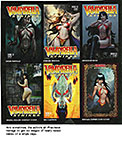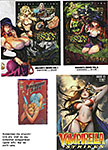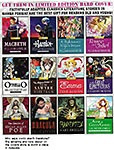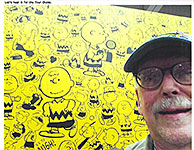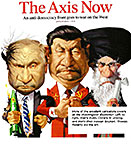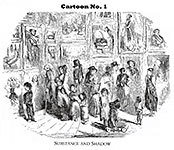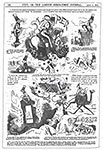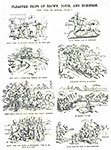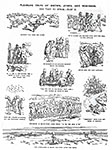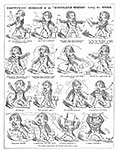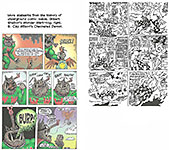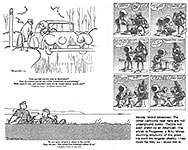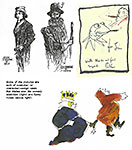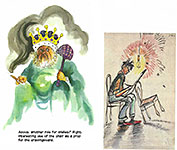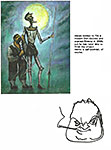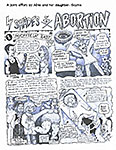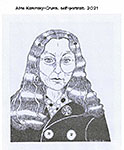 |
|||||||||||||||||||||||||||||||||||||||||
Opus 427a (March 29, 2022): We review over 60 editoons from the past month and conduct a biography of editoonist Dick Wright, who has returned to the fold after a 17-year retirement that didn’t work out. We watch Crankshaft explain the current newspaper crisis and applaud Sally Forth’s unusual 40th anniversary celebration. And we review books and comicbooks. And we report on Biden’s State of the Union, Zelensky’s speech to Congress, and Will Smith striking a blow for love at the Oscars. In order to assist you in wading through all this plethora, we’re listing Opus 427a's contents below so you can pick and choose which items you want to spend time on. An asterisk* marks the longest items. Here’s what’s here, by department, in order, beginning with the news of the day—:
NOUS R US Annotated Marvel No.1 Sells for Millions Gibbons’ Autobiography Forthcoming *Will Smith Strikes a Blow for Love Cartoon Crossroads Returns In Person NCS To Meet in September U.S. Manga Sales More than Doubled in 2021 *Marvel and DC Announce Pride Plans Seuss Studios Will Feature Vintage Art and New Voices Neighborhood Mini-con *Zelensky Speaks to U.S. Congress The Nation’s View
**WRIGHT’S BACK Editoonist Returns After 17-year Retirement FUNNYBOOK FAN FARE Grrl Scouts Stone Ghost Monkey Meat The Me You Love in the Dark
TRUMPERIES The Antics and Idiocies of Our Bloviating Buffoon in Chief
**EDITOONERY The Mock in Democracy With a few gag cartoons sprinkled along the way for the sake of relief
THE FROTH ESTATE The Alleged “News” Institution *Crankshaft Explains the Newspaper Crisis
NEWSPAPER COMICS PAGE VIGIL The Bump and Grind of Daily Stripping *Sally Forth Celebrates Its 40th Anniversary And Other Shenanigans
GOSSIP & GARRULITIES *State of the Union
BOOK MARQUEE Short Reviews, to wit—: Rebirth of the English Comic Strip Zap Comix No.16 The Collected Zap Comix Orson Welles Portfolio of Sketches and Drawings
ONWARD, THE SPREADING PUNDITRY Explaining the Trumpet & Other Delights
QUOTE OF THE MONTH If Not of A Lifetime “Goddamn it, you’ve got to be kind.”—Kurt Vonnegut Our Motto: It takes all kinds. Live and let live. Wear glasses if you need ’em.
But it’s hard to live by this axiom in the Age of Tea Baggers, so we’ve added another motto: Seven days without comics makes one weak. (You can’t have too many mottos.)
And in the same spirit, here’s—: Chatter matters, so let’s keep talking about comics. AND— “If we can imagine a better world, then we can make a better world.”
And our customary reminder: don’t forget to activate the “Bathroom Button” by clicking on the “print friendly version” so you can print off a copy of just this installment for reading later, at your leisure while enthroned. Without further adieu, then, here we go—:
NOUS R US Some of All the News That Gives Us Fits
ANNOTATED MARVEL NO.1 SELLS FOR MILLION$ By Alyssa Lukpat at NYTimes.com A rare piece of Marvel history, a publisher’s annotated copy of Marvel No.1, the first Marvel comic book, sold at auction on March 17 for $2.4 million. Published in 1939, the book is so valuable because it is known as the pay copy, in which the publisher recorded the payments he owed to the artists, explained Stephen Fishler, the chief executive of ComicConnect, an online comic auction house. The anonymous buyer is a longtime comic collector in his 40s who lives outside the United States. “He loved the condition of the copy and the story of how it was found,” Fishler said. For collectors, comics that contain the first appearances of superheros like Batman and Spider-Man are precious. A 1962 copy of Amazing Fantasy No. 15, featuring Spider-Man’s debut, sold last year for $3.6 million, which was believed to be a record. In January, a buyer spent $3.18 million on a 1938 copy of Action Comics No. 1, which featured Superman’s debut. The 68-page Marvel Comics No.1 introduced Namor the Sub-Mariner, a mutant who lives under the sea; and the original Human Torch, whose body can catch fire (not to be confused with the similar Fantastic Four character introduced in 1961). The auctioned copy is in remarkable condition for a book that is more than 80 years old, perhaps because it had been hidden in a file cabinet until it was discovered in 1993 or 1994, Fishler said. The cabinet had belonged to Lloyd Jacquet, who started a company, Funnies Inc., which sold comic book stories and artwork to publishers. Jacquet died in 1970. “It was a freak of nature that this book was saved,” Mr. Fishler said. On the cover and seven of the pages, Jacquet wrote how much his company owed artists including Frank R. Paul, who was paid $25 to illustrate the cover, Fishler said. Owning the pay copy of Marvel Comics No. 1 would be like owning a first-edition Charles Dickens novel in which he documented his royalties, said Douglas Wolk, who has read all 27,000 Marvel comic books and summarized them into a single narrative for his 2021 book, All of the Marvels. Fishler said that the most recent owner of the annotated copy of Marvel Comics No. 1 auctioned it because he wanted to buy a house. “That worked out very well,” he said. GIBBONS’ AUTOBIOGRAPHY FORTHCOMING Dark Horse Books will publish Dave Gibbons’ autobiography, Confabulation, in October. The book promises to feature Gibbons discussing the dissolution of his working relationship with Watchmen co-creator Alan Moore, according to Joe Grunewald at comicbeat.com. “Dave Gibbons is an icon of the comics industry,” says Grunewald, “with writing and artistic credits on hundreds of British and American comics, but there’s one story Gibbons has yet to tell: his own.” Confabulation, subtitled An Anecdotal Autobiography, promises to be a collection of prose and artwork by Gibbons, presented in alphabetical order, that follows his life and career. Here’s how Dark Horse describes the forthcoming 325-page volume—: Presented alphabetically, with informally written anecdotes that can be read from cover-to-cover or simply dipped into, Gibbons reveals unseen comics’ pitches, life as the first Comics Laureate, adventures in advertising and album cover design, and his journey from fanzine artist to infiltrating DC Comics in the 1970s. This book covers everything from his work on Doctor Who and meeting Tom Baker to his induction into the Eisner Hall of Fame. Gibbons also discusses, for the first time anywhere, the end of his relationship with fellow Watchmen co-creator Alan Moore. Packed with over 300 iconic, rarely seen, and unpublished art pieces and photographs, Confabulation: An Anecdotal Autobiography not only entertains, but peels back the layers of a fascinating career in comics. Gibbons has worked with dozens of legendary comics creators over his four-plus-decade career, [but] it’s his collaborations with writer Moore on Watchmen and the iconic Superman story “For The Man Who Has Everything” that Gibbons is perhaps best known for, and Confabulation promises to reveal more about the pair’s relationship than ever before. RCH: And it’s all to be presented “alphabetically”? How’s that, exactly? How do you alphabet your life? What comes under the “a’s”? I can’t wait to see.
HOW WILL SMITH STRUCK A BLOW FOR LOVE By TEGNA, Associated Press; Lightly Supplemented by RCH In one of the most shocking moments in Oscars history, actor Will Smith slapped comedian Chris Rock in the face onstage at the 94th Academy Awards Sunday March 27 after Rock made a joke about Smith's wife, Jada Pinkett Smith. The moment shocked the Dolby Theatre audience and viewers at home. While Rock was telling the next joke, Smith strode across the stage and slapped the comedian in the face. “Wow,” exclaimed Rock. “Will Smith just smacked the shit out of me.” “Keep my wife’s name out of your fucking mouth,” Smith shouted as he returned to his seat. “Wow, dude,” Rock said after a moment of silence, “—it was a G.I. Jane joke,” an allusion to “G.I. Jane” in which Smith’s wife was appearing. Smith, now in his seat, repeated his statement. A few minutes later, a tearful Smith returned to the stage to collect the best actor Oscar for his portrayal in “King Richard” of Richard Williams, who trained his daughters to be tennis champions. Smith’s acceptance speech wavered between defense and apology. He began by citing Richard Williams’ defense of his family which Smith’s action a few minutes earlier had paralleled on the Oscar stage. Here's the full text of what Will Smith said during his best actor acceptance speech: "Richard Williams was a fierce defender of his family. In this time in my life, in this moment, I am overwhelmed by what God is calling on me to do and be in this world. Making this film, I got to protect Aunjanue Ellis, who is one of the most strongest, most delicate people I’ve ever met. I got to protect Sinai and Demi, the two actresses that play Venus and Serena. I’m being called on in my life to love people. And to protect people and to be a river to my people. “I know, to do what we do, you got to be able to take abuse. You gotta be able to have people talk crazy about you. In this business you gotta be able to have people disrespecting you and you gotta smile and pretend like that’s okay. “Denzel said to me a few minutes ago, he said ‘At your highest moment, be careful, that’s when the devil comes for you.’ It's like, I want to be a vessel for love. I want to say, Thank you to Venus and Serena and the entire Williams family for entrusting me with your story. “That's what I want to do. I want to be an ambassador of that kind of love and care and concern. “I want to apologize to the Academy, I want to apologize to all my fellow nominees. This is a beautiful moment and I’m not crying for winning an award. It’s not about winning an award for me, it’s about being able to shine a lot on all the people Tim and Trevor and Zach and Sinai and Demi and Aunjanue and the entire cast and crew of King Richard and Venus and Serena and the entire Williams family. “Art imitates life. I look like the crazy father, just like they said about Richard Williams! But, love will make you do crazy things. “To my mother, this moment is really complicated for me but to my mother, she didn't want to come out she has a knitting crew that she's in Philly watching with. Being able to love and care for my mother and my family, my wife, I'm taking up too much time. Thank you for this honor, thank you for this moment and thank you on behalf of Richard and the entire Williams family. I hope the Academy invites me back." By the next morning, Academy officials were already talking about ways to discipline Smith—including taking away the Oscar he’d just won. Well, shoot, guys. Okay, we admit that Smith was seriously out-of-line here. Moreover, he managed to give racists more ammunition (“See—these two Black guys fight even at the Oscars”). But he may know how keenly his wife felt about losing her hair (which was somewhere near the bottom of the joke Rock told) and how badly she might feel at being held up for ridicule by Rock—thereby justifying his extreme response. But take away his Oscar? Nah. Don’t perpetuate the same kind of adolescent behavior that you think you’re disciplining.
Mark calendars for October 6 - 9 CARTOON CROSSROADS RETURNS IN PERSON!! Ditto AAEC Cartoon Crossroads Columbus (CXC), the international showcase for cartoon art, is excited to announce its return to an in-person show for the fall of 2022. This year’s show will take place from October 6 to 9 and will feature a guest list of renowned and up-and-coming creators and the return of the expo on the Saturday and Sunday of the festival, 8th and 9th. And the Association of American Editorial Cartoonists (AAEC) will be meeting at the same time and place. All events are free to the public. “We are excited to put a spotlight on the best in the cartoon arts and bring artists and fans together,” says Jay B. Kalagayan, CXC’s new executive director. “We learned invaluable lessons during last year’s event, working with our partners on maintaining a safe environment for our artists and attendees.” “It’s our eighth annual Festival and we are optimistic that this is the year we will finally see more of each other in person,” said Jeff Smith, CXC’s co-founder and artistic director, and author of the Bone graphic novels. “This October CXC promises to be an exciting return to form with more of the world’s great cartoonists, as we continue to celebrate the history and creators of our favorite art form!” Festival organizers will have more information about CXC 2022 in the coming months. Follow CXC on social media (Twitter, Facebook and Instagram) or check cartooncrossroadscolumbus.org for the latest. CXC aims to provide an international showcase for the best of cartoon art in all its forms, including comics, animation, editorial cartoons, newspaper strips, and beyond, in a city that is a growing center of importance to comics and cartooning. The festival also focuses on helping the next generation of young talent develop careers that invigorate the industry for years to come. The Festival’s association with Columbus and Ohio is a mere accident of history—cartooning history. The city and state are considered (by Festival founders at least) “the cradle of great cartoonists”—more of America’s cartoonists are associated with Ohio and/or Columbus than any other locale in the U.S. They were born there or grew up there or went to college there. The fact that Ohio State University is also the home of the Billy Ireland Cartoon Library & Museum, perhaps the most extensive collection of cartooning artifact and lore, helps, too. In fact, I doubt that CXC would exist were it not for the Ireland.
NCS To Meet in September Violating a tradition of decades, the National Cartoonists Society will meet in the fall rather than the spring this year as it returns to an in-person Reubens convention. Prez Jason Chatfield announced that the 76th Annual Reuben Awards will take place in Kansas City, Missouri on Thursday and Friday, September 15-16, 2022. Chatfield explained that he tried to find spring dates but couldn’t: many organizations that couldn’t meet last year due to the pandemic were scrambling to secure dates this year and filled up the calendar pretty fast. September was as close to summer as he could finagle.
U.S. MANGA SALES MORE THAN DOUBLED IN 2021 NPD Reports Sales Up 160% in Units Manga’s great year in 2021 is not a surprise, said Milton Griepp; we’ve been seeing the category dominate in our monthly Top 20 Adult Graphic Novels charts, often accounting for most or all of the Top 20. We’ve also been seeing manga appear among the top sellers in comic stores, a rare appearance over the past decade. Unit sales of manga in NPD-tracked accounts were 24.4 million units in 2021, up 15 million units from 2020, a growth rate of around 160%. Due to a classification issue involving some titles of My Hero Academia, the actual number of manga units sold was likely larger for both years, which might have affected the growth rate somewhat.
MARVEL AND DC ANNOUNCE PRIDE PLANS In a pair of PR announcements released on Tuesday, March 15th, Marvel Comics announced their Pride offerings for 2022, said Avery Kaplan at comicsbeat.com, who adds: Per what we can only guess would be Disney’s wishes, the news write-up complies with Florida’s “Don’t Say Gay” Bill. No mention of Pride coupling the word “pride” to “gay,” so unless readers are alert and thoroughly woke, the momentousness of the announcements will evade them. This year at DC, the publisher is once again pulling out all the stops for Pride: the publisher announced that 2022 will see a new, 100+-page DC Pride anthology special, variant covers, and a quartet of new books starring Poison Ivy, Kid Quick and Teen Justice, Nubia, and Tim Drake. Comics books have been a welcome home for LGBTQ+ fans for a while now. Back in 1988, DC had their first openly gay character, Extraño. A few years later, in 1992, Marvel published an emotional issue of Alpha Flight. In the comic, Northstar revealed he was gay. Later, Northstar would have the first gay wedding in Marvel history. But although they had LGBTQ+ characters, it wasn’t until the past few years that the major comic publishers fully embraced their pride. This year, both publishers announced all the titles commemorating Pride 2022. Both Marvel and DC will put out a new Pride anthology. Each issue will be around 100 pages of new content. Marvel’s Voices: Pride No.1 will have about seven different mini-stories. The Young Avengers team reunites in this special issue. Other stories feature Moondragon, Somnus (introduced in last year’s Pride issue), and Hercules. The 104-page DC Pride 2022 anthology one-shot will kick off DC’s Pride celebration with covers by Phil Jimenez (main), Joshua “Sway” Swaby (open-to-order variant), and Jen Bartel (1:25 variant). According to Joe Grunenwald, actress and writer Nicole Maines will provide an introduction for the special, which DC says will also tease a new project she’s working on for the publisher. Marvel’s Voices: Pride will feature a lot of great creators on some pretty interesting-sounding stories, says Kaplan. These will include Charlie Jane Anders, who recently made her Marvel Comics debut in another anthology, Women of Marvel No.1. Just as Somnus was introduced in Marvel’s Voices: Pride last year, the PR promises that Anders will be introducing us to a new Marvel hero in this anthology. Also particularly exciting, Kaplan continues, is the Marvel Comics debut of Grace Freud. The funniest and most insightful stand-up comedian working today (yes, she’s funnier than whatever dude you’re thinking of) worked with Scott B. Henderson on a story about “the Marvel Universe’s favorite ginger, D-Man!” Another Marvel Comics debut for this issue will be Andrew Wheeler, writing a story about Hercules that will feature art by Brittney Williams. And the debuts keep coming, with Ira Madison III exploring the “legacy of Pride.” In addition, Chris Cantwell will pen a tale about Moondragon, Alyssa Wong will work with Stephen Byrne in a story that will reunite the Young Avengers, and Danny Lore writes a tale about two closeted characters.
SEUSS STUDIOS WILL FEATURE VINTAGE ART AND NEW VOICES Unpublished Dr. Seuss sketches and illustrations will inspire new Seuss works, reports Sally Lodge at publishersweekly.com. Seuss Studios, a joint venture of Dr. Seuss Enterprises (DSE) and Random House Children’s Books (RHCB), made ther announcement on March 2, the date of Ted Geisel’s 118th birthday. Seuss Studios will debut in 2023 and will announce details about the inaugural list later this year, but we know that the new imprint will publish a line of books for early readers by new and emerging authors and illustrators, who will create original stories inspired by Dr. Seuss’s unpublished work. The images that will spark the imaginations of Seuss Studios authors and artists have been selected from the Dr. Seuss Collection archives located at University of Callifornia San Diego and curated by DSE and RHCB. The original Dr. Seuss sketch that serves as the basis for each story will be included in the book, along with a note from the creators explaining how they were inspired and detailing their creative process.
NEIGHBORHOOD MINI-CON We (my wife and I) exhibited at a one-day comic-con near our home on a recent Saturday. It was my first comics outing since the pandemic, and I was curious about the attendance. Would everyone wear a mask? It
wasn't my crowd, though. I sold only one book. The thing was billed as a
comic-con, but there were only 3 or 4 exhibit tables devoted to cartooning—one
guy selling comicbooks from boxes, a friend of mine doing caricatures, and at
another table, a box or two of graphic novels. The rest— maybe 20-30 tables—
all pop culture stuff, decorative pins, toys, figurines, and parts of costumes. One of the big features of the event were the costume contests, 3-4 of them, scattered through the day. So we saw lots of cosplay from our exhibit table: it just went by in parades. I
watched a little girl, maybe 3-4 years old, dressed as Wonder Woman and pushing
a stroller along with her doll seated on it. The contradictions were lovely: a
very young girl playing a seasoned superhero warrior; the stroller, motherhood
and superheroing; make-believe mother and Another memory was the chest of a very large (fat) woman. The chest itself was memorable, but the memory was enhanced by her choice of wardrobe. She wore a t-shirt with words lettered on its front. Words and words and words. Whole sentences (yes, at least two). It started: "I’m afraid no one will like the comics I made, so ....” And it went on for an entire paragraph. My realization here was that only on a truly massive chest could one affix a message of such great length. And masks? My wife and I were the only ones wearing masks.
************* THE WAR AND ALL******************
ZELENSKY SPEAKS TO U.S. CONGRESS By Damon Linker at The Week online, March 16, 2022 In his address to Congress Wednesday morning, March 16, President Volodymyr Zelensky of Ukraine made a powerful, heartrending appeal for additional aid, including a no-fly zone and additional weaponry, to help his country defend itself against Russia's invasion. The U.S. government should keep imposing painful economic sanctions on Russia and sending defensive weapons to Ukraine. But nothing in Zelensky's emotionally potent presentation should change President Biden's rejection of a no-fly zone and more escalatory moves on the ground in Ukraine. That line might prove difficult to hold. As the world has learned in the three weeks since Russia's invasion began, Zelensky is a charismatic leader whose extraordinary courage is his country's most formidable asset against Russia's aggression. On Wednesday, he pulled out all the rhetorical stops, both verbally and visually, in making his case for stepped up American assistance. He began by evoking America's relatively few memories of the horror of aerial bombardment — at Pearl Harbor on Dec. 7, 1941, and at the World Trade Center and the Pentagon on Sept. 11, 2001. Imagine the shock and terror of those mornings continuing through the afternoon and evening and on through the days and weeks to come — that's the chilling thought Zelensky tried to plant in the minds of his audience before asking (in language drawn from Martin Luther King's "I Have a Dream" speech) for the U.S. to impose a humanitarian no-fly zone. Then he pivoted to American ideals — our hope for a world of peace and prosperity in which all nations respect human rights and everyone lives in freedom. That set up a brutal contrast to a video Zelensky showed next, with scenes of Ukraine's peaceful cities and happily playing children giving way to images of explosions, collapsing apartment blocks, and dead children on blood-spattered hospital beds. A soundtrack of keening strings made sure no one missed the point: This is happening right now, right before your eyes. You could do more to stop it, yet you are hesitating. Don't let Russian President Vladimir Putin get away with this. Do more to help us defend ourselves and win — or act as passive accomplices in our defeat, which will be a defeat for everyone who shares America's values. It was impossible to listen to Zelensky's appeal and not be moved. But that doesn't mean we should let ourselves be moved to change course. Americans are fortunate to have a president at this moment who has done so much to help Ukraine, rally Europe against Putin, and impose painful economic penalties on Russia for its actions — while also holding the line on military escalation. Turn on cable news, scroll through Twitter, or scan the opinion pages of the country's leading newspapers and magazines and you'll be barraged with calls to do more, far more, to defend Ukraine and humiliate Putin. Some of the suggestions are close calls. (I think the case for transferring MiG fighter jets to Ukraine from Poland is strong and worry Biden might have displayed a mite too much caution in nixing the plan.) But most are reckless — highly emotional responses to wrenching events with insufficient care and attention paid to potential dangerous consequences. A no-fly zone was a bad idea last week, and it's still a bad idea now. Yes, the prospect of any direct military clash between the U.S. or NATO and Russian forces could end in a nuclear conflagration. But there are plenty of possible bad outcomes short of apocalypse. Enforcing a no-fly zone means engaging and possibly shooting down Russian planes. It also means exposing our pilots to anti-aircraft batteries on the ground, which we would have to neutralize. That means war. Not necessarily involving nukes, but war nonetheless. It's hard to imagine anything more likely to revitalize popular support for Putin and his misbegotten escapade in Ukraine than its transformation into a battle with NATO for Russian honor. Russia's invasion is going poorly. Putin might still be capable of inflicting pain on civilians, but any hope he might have had to install a puppet regime in Kyiv capable of defending itself against an insurgency, let alone directly occupying Ukraine as a whole, has already slipped away. Hence the compromises Moscow has already begun to offer in peace negotiations. The last thing Zelensky should want to see now is a widening of the war that gives Russia something bigger to fight for. Ukraine should be seeking, with our support, to grind Putin down, deny him victories, and give him defeats, weakening his negotiating position to such an extent that he's ultimately willing to accept far less than he was seeking when he made the fatal blunder to send Russian troops across the border. That can happen, but only if we stay the course, resisting the temptation to play a bigger role in the conflict than we already are. That means sticking with Biden's approach: sending weapons and other materiel, squeezing Russia economically, but staying out of the fight, and allowing the Ukrainian people to defend themselves. Zelensky might not like the prospect of standing alone. But it's by far the best among the bad options confronting his country in its ongoing moment of trial.
The Nation says “not so fast.” In an editorial, the magazine’s editors condemn Putin’s invasion as a blatant violation of international law. But while Putin’s actions are indefensible, responsibility for this conflict is widely shared. The magazine says it has warned repeatedly that extending NATO to Russia’s borders would inevitably produce a dangerous reaction and has criticized NATO’s wholesale rejection of Russia’s security proposals. However unpopular it may be to point this out, the expansion of NATO provided the context for this crisis—a history too often ignored by our news media. Offering future NATO membership to Ukraine—when successive US presidents and our NATO allies have demonstrated that they do not have the slightest intention of fighting to defend the country—was deeply irresponsible. Instead, Putin’s demand that Ukraine remain outside of NATO— essentially that the status quo be codified—was scorned as violating NATO’s “principle” of admitting anyone it wanted. One result was to encourage parallel irresponsibility by Ukraine. Campaigning for office, Zelensky promised if elected he would end the war in the Donbas. But upon taking office, he refused to implement provisions of various treaties that would have guaranteed sovereignty and territorial integrity for Ukraine in exchange for its neutrality—a status similar to that of Austria, Norway and Finland. ... Though the situation is extremely perilous, we believe the crisis can still be resolved by the withdrawal of Russian forces from Ukraine—including the Donbas—alongside a declaration of Ukrainian neutrality. The magazine urges the U.S. and other observing parties to encourage the latest talks and, if need be, to help facilitate the hard but necessary work of diplomacy.
Zelensky’s Reality Show. Volodymyr Zelensky, comedian turned his country’s president, once pretended to play a piano with his penis on television. A former contestant on Ukraine’s “Dancing with the Stars” (he won in 2006) and the Ukrainian voice of Paddington Bear, Zelensky created and starred in a satirical 2015 tv series called “Servant of the People” in which he played a sympathetic everyman who accidentally becomes president. Writing in Washington Examiner (March 15), J. Oliver Conroy said “Servant of the People” is somewhere between “Veep” and “Yes Minister” with a dash of “Mr. Smith Goes to Washington.” Zelensky’s
character is Vasily Goloborodko, “a divorced high school history teacher who
lives with his parents. He’s a “But his slightly embittered exterior conceals an earnest idealist. One day at school in front of his classroom, he explodes, uncharacteristically, in a profanity-laced rant about corruption. His students surreptitiously film the diatribe, and it goes viral online. Goloborodko awakens one morning to discover that he has been elected president.” The parallels to Zelensky’s actual career are shiveringly close. In a scene in the tv show, Goloborodko/Zelensky assigns a challenging task to one of his civil servants, who responds, “Are you joking?” “Do I look like a comedian?” Goloborodko/Zelensky replies.
FROM PROFANITY TO FAME Ukraine has
chosen the image for a new postage stamp called “Russian warship, go fuck
yourself!” to commemorate the Snake Island incident, in which 13 border guards
stationed on a roughly 16-hectare (40-acre) rocky island about 186 miles
(300km) west of Crimea reportedly replied, when asked to surrender: “Russian
warship, go fuck yourself!” They were then The phrase has become a rallying cry for Ukraine’s defenders to try to keep morale high and win the PR battle against invading Russian forces, reports Chris Milchael at theguardian.com. Ukrainian president Volodymyr Zelenskiy announced he would posthumously award all the Snake Island soldiers the Hero of Ukraine award, though it was later reported that they may in fact still be alive.
KILL PUTIN? Joe Biden’s remark that Russian Prez Vladimir Putin “cannot remain in power” was not intended as a call for regime change in Moscow, Biden later explained. It was merely his expression of frustration and outrage that such a man should be in power. And that raises a question that has nowhere, as far as I know, been raised about Putin: if he is the sole cause of our present difficultly with NATO and Ukraine, and with killing civilians in wartime, why not just remove him? Have him assassinated? The short answer is: because we’ve tried it before and failed every time. Dwight Eisenhower is the first Prez of modern times to call for the murder of a foreign leader. First, he wanted China’s Zhou Enlai done in. They tried exploding the airplane he was supposed to be on; but he wasn’t, so that scheme failed. They tried poison; nothing. They tried to eliminate Patrice Lumumba, prime minister of the Congo; nope, not by American hands or plots. He was executed but no American plot achieved it. Both Eisenhower and John Kennedy tried to get Fidel Castro. No luck. Then Dominican dictator Rafael Trujillo; that worked. Next, it was South Vietnamese Prez Ngo Dinh Diem; that, too, eventually worked, but Kennedy, by then, was against it. In short, ordering the killing of foreign leaders isn’t something we’re good at. We’ve failed too often to be encouraged. Putin will probably escape the assassin’s bullet.
Fascinating Footnit. Much of the news retailed in the foregoing segment is culled from articles indexed at https://www.facebook.com/comicsresearchbibliography/, and eventually compiled into the Comics Research Bibliography, by Michael Rhode, who covers comic books, comic strips, animation, caricature, cartoons, bandes dessinees and related topics. It also provides links to numerous other sites that delve deeply into cartooning topics. For even more comics news, consult these three other sites: Mark Evanier’s povonline.com, Alan Gardner’s DailyCartoonist.com (now operated without Gardner by AndrewsMcMeel, D.D. Degg, editor); and Michael Cavna at voices.washingtonpost.com./comic-riffs . For delving into the history of our beloved medium, you can’t go wrong by visiting Allan Holtz’s strippersguide.blogspot.com, where Allan regularly posts rare findings from his forays into the vast reaches of newspaper microfilm files hither and yon.
FURTHER ADO It is better to spend money like there’s no tomorrow than to spend tonight like there’s no money.—P.J. O’Rourke
WRIGHT’S BACK And His Front, Too I started seeing editoons signed “Dick Wright” about a year ago. I was surprised at how good they were: well-drawn with sharply pointed commentary. Highly polished stuff. No beginner, he. And he was a rarity: he was a conservative in a profession whose practitioners are overwhelmingly liberal. In
the accompanying illustration, the cartoons in color are contemporary; the
fourth cartoon is from 2020 or 2021. Where did this guy come from I wondered. And so I looked him up a couple weeks ago. I learned that Wright, 78, has returned to the drawingboard after a 17-year retirement. He had left editooning to follow a higher calling—church pastor at a church he founded in Warrenton, Virginia. But recent events on the American political front were too much: he could no longer sit idly by and watch while liberal Democranks run his state: Said Wright: “Since the election of Governor Northam, and the Democrats taking both chambers of the legislature in Virginia, I have been motivated to draw cartoons again that are opposed to the new socialist agenda of the Democrats.” He posts new cartoons at his Facebook page, where he adds a paragraph of editorial annotation to each drawing, and his work is also distributed by Cagle Cartoons. Daryl Cagle was particularly happy to welcome Wright to his syndicate: “I’m pleased to announce that we have added conservative cartoonist, Dick Wright, to our CagleCartoons.com newspaper syndication package! Dick has been one of America’s top editorial cartoonists for over 32 years ... [And] now he’s inspired to come back to syndication with us. Conservative cartoonists are rare, and great conservative cartoonists are extremely rare; we’re delighted to have Dick join our cartoonists and we look forward to seeing him give more weight to the right side of our left leaning group.” Editor & Publisher’s David Astor traced Wright’s career at the time of his retirement. “He worked for the San Diego Union-Tribune, starting in 1976 and later joined The Providence (R.I.) Journal, the Nashville (Tenn.) Banner, and The Columbus (Ohio) Dispatch. Currently, he’s affiliated with the Gwinnett Daily Post of Lawrenceville, Georgia.” His editoons were distributed at various times by the McNaught Syndicate, Copley New Service, the Los Angeles Times Syndicate, and Tribune Media Services. “While he’ll no longer be a professional cartoonist,” Astor continued, “Wright said he may do some drawings for church publications.” Cartooning was almost a sidetrack for Wright. In college, he majored in finance, which is about as far away from cartooning as you can get. And when he considered a career, he initially chose engineering, having abandoned finance as a possibility. But Wright has been engaged in church work from a very young age. The Washington Post’s Mike Rhode interviewed the editoonist upon his return to the profession. “I grew up in church,” he told Rhode. “I had a very powerful experience with God at about the age of thirteen. From that time forward, I was deeply engaged in church and was very focused on spiritual things. On my own I began to read the Bible every evening before going to sleep. In reading the Bible, I learned a lot about God and it changed me. Even as a young teen, I became very interested in someday serving the Lord as a pastor. “My parents were middle class. We struggled financially even as my dad worked two and three jobs as far back as I can remember. When it came time for me to go to college, I did not have the heart to ask for help in going to college. I was interested in going to a bible college to become a pastor. Instead, I attended junior college with no particular direction. “I dropped out and got a job as a draftsman because I could draw. In those days we actually drew by hand the things we were building. I advanced quickly and moved up to a junior designer at the Jet Propulsion Lab in Pasadena, California. I became interested in engineering. “By then I was married with two little girls. I wanted to become a senior designer, but you had to be degreed. So I went to Long Beach State studying engineering and worked full time.” That’s when cartooning sidetracked him. “ While I was at Long Beach State, I began to draw cartoons for the university newspaper, The ’49er. I did this for a couple of years and finally I went to some local newspaper editors and asked them what they thought of my work. They were very encouraging and began to print a few. This changed my whole direction. “I began to consider changing my career goal from engineering to cartooning. I spent about two years contacting newspapers looking for a job. Finally, I was hired at the San Diego Union as their back-up cartoonist and illustrator and I was on my way. “It didn't take long for my editorial cartoons to be used more and more, and I became the lead cartoonist. I was in San Diego for about eighteen months and then moved to The Providence Journal, and that is where my career took off. “I was focused on being as good as I could be. I would get up at about four in the morning and read the paper cover to cover. My intent was to know what was going on so my cartoons had substance. I worked at it. I became syndicated, and my list of papers grew to about 420. This was a lot, since at that time there were only about 1,700 dailies in the country. “This went on for years, but I never forgot the early experience I had with God and my very distinct call to be a pastor. As my list of papers grew, I reached my limit. I began to struggle to keep the numbers up and had to work harder just to stay even. “I began to realize that there was no way I could sustain what I had been doing for years, and I became discouraged. I began to question what I was doing, and for what? At this time I began to think about becoming a pastor and fulfill that early calling. I was 52 at the time. “I began to seek out what was necessary to become a pastor. I had a friend who was a pastor who told me that in Virginia all you needed to become a pastor was to be ordained by a church and I could become a pastor. His church ordained me as I had 30 years’ experience leading and teaching the Word. Within a month I had gathered together a group of 21 people and we started a church, and I was the pastor. “In 12 weeks the church grew to 100 attenders. Three years later we completed a new church building. In five years, my church had grown to more than 400. I retired and then came out of retirement to help another small church get established.” Wright is self-taught as a cartoonist although he credits Mad’s Mort Drucker with giving him crucial encouragement. “When I started cartooning, I was pretty rough,” Wright said. “I guess that given where I started, I am most proud of what I developed into. My work now is a far cry from when I started. I had some help along the way. Mort Drucker was a great encouragement to me as well as editorial cartoonist Karl Hubenthal in Los Angeles. ”When I was trying to get into cartooning,” Wright continued, “I wrote Mort a letter with some of my work [aimed at] Mad magazine. I received a letter back from him. He was gracious and encouraging. He offered advice about cartooning that was very helpful. “One of the things he told me was that every assignment I get and send off should be better than the last job I did. He said this was the way to get better. He said that when you plateau and level off, keep working at doing better than your last job. He said this is how he improved. “Mort was a very kind and gracious man. Many years later, when I was the cartoonist at The Providence Journal, I was involved is getting the program set for an editorial cartooning convention. I contacted Mad and talked to the editor and invited all the Mad cartoonists to the convention in Newport. Mort and Jack Davis showed up along with some others. What a thrill! I have a photo of Mort and myself taken at the mansion where we were hosting the convention. He was so gracious and kind to me. What a great cartoonist, a great man. I miss him.” Near here, we’ve posted examples of Wright’s work culled from a collection of his cartoons, If He Only Had A Brain. Published in 1998, it shows Wright was taking shots at Prez Bill Clinton a lot.
QUIPS & QUOTES From Counterpoint—: Counterpoint’s counterparts in Warsaw have contacted us with a proposition. See, they’ve got a bunch of Polish editorial cartoons that were actually drawn in Russia. And they’re offering to send them to Kyiv so the Ukranians can use them to ridicule the Russians, okay? But they want us to send them a bunch of editorial cartoons from America just in case Russia invades Poland, and the Poles say they want to route their cartoons through a post office box at Ramstein Air Base but the Biden administration says we can’t do it because it doesn’t want to get into a fight with the Russians. So, sorry Ukraine, you’ll just have to fend for yourself. All of which seems so crazy it be funny if it weren’t so serious.
FUNNYBOOK FAN FARE Four-color Frolics An admirable first issue must, above all else, contain such matter as will compel a reader to buy the second issue. At the same time, while provoking curiosity through mysteriousness, a good first issue must avoid being so mysterious as to be cryptic or incomprehensible. And, thirdly, it should introduce the title’s principals, preferably in a way that makes us care about them. Fourth, a first issue should include a complete “episode”—that is, something should happen, a crisis of some kind, which is resolved by the end of the issue, without, at the same time, detracting from the cliffhanger aspect of the effort that will compel us to buy the next issue. A completed episode displays decisive action or attitude, telling us that the book’s creators can manage their medium.
SOMEWHERE NEAR
HERE, at the elbow of your eye, we’ve posted a scan of the cover of the first
issue of Jim Mahfood’s newest iteration of his Grrl Scouts series, this
one, “Stone Ghost.” The imagery of this cover art, a few floating fishes and a
monstrous head with shooting eyes notwithstanding, is the most easily
deciphered and understood of all the images in this book. Next to the cover,
we’ve posted what I’m calling a “typical” Mahfood page. The thing that helps
most in grasping the narrative implications are speech balloons: their words
help us see what’s happening. And what’s happening throughout No.1 and No.2 is a visual delight. Mahfood’s work is a celebration of comicbook imagery—indeed, of imagery generally. He clearly gets off on what pictures can do. And once he gets started on a page—let’s imagine he starts putting pen to paper at the upper lefthand corner—he simply goes bananas making pictures. Some of the imagery has almost nothing to do with the story he’s telling. It’s just part of the atmosphere of the book. He helpfully breaks it all into what seems to be an array of panels, but the breakdown is nearly perfunctory, and the panels mostly imaginary. Does this mean Mahfood simply doesn’t grasp what a plot is? Decidedly not. He knows. And his knowledge is evident even amid the seemingly haphazard array of his images. The big image at the bottom of the page at hand is of the back of the character Turtleneck Jones, the hired gun who’s been hired by the book’s heroine, Dio, to help her retrieve the ashes of her dead boyfriend, which reside in a distant corner of the universe. That’s the governing element of the story, the heart of the plot. But what’s so interesting about Turtleneck Jones’ back that Mahfood spends almost half a page illustrating it? Dunno. It’s as if Mahfood, once he gets started on a page—at that hypothetical upper lefthand corner—he simply doodles his way along, pausing every once in a while to insert a picture of his heroine or some other character. Is this bad? Heck no! For someone like me for whom comics are a visual artform, pictures are the name of the charade. And I delight in watching what Mahfood does with them almost as much as he does in making them. The
next illustration posted near here is a two-page spread showing Turtleneck
Jones committing suicide by shooting himself in the head. Admittedly, this is
an event worthy of the display that a two-page spread provides. But Mahfood
goes far beyond the narrative needs in his imagery. Doodles galore infest the
image. And what can you make of that looping line that spins across the bottom
of the picture at the lower right? What purpose does it serve? None. It is merely—emphatically—a clue to Mahfood’s motivation. Make a delightfully interesting picture. And once you’ve decided that’s his principal goal in producing this comicbook series, you have the means by which Mahfood’s work can be enjoyed. And you’ll rejoice in the looping lyricism of that otherwise meaningless line at the lower right. You
can also enjoy the images we’ve culled from No.2, posted hereabouts. One
depicts a menacing hooded figure, who works for “Teeth,” the master villain of
the piece; in breakdown, this is one of the more orderly pages in the book. The
page next to it is a flashback, for which Mahfood resorts to a different but
more straight-forward layout of panels. Here, Dio tells us of her love affair
with Billy, who died of brain cancer. See? Breakdown. Flashback. Elements of plot and story, elements that Mahfood manipulates with aplomb. Next comes a two-page sequence culminating in Turtleneck Jones’s corpse demonstrating some liveliness. Yes, he soon returns to life. By then, Dio has been adopted by a new defender, who says of Turtleneck that his body must be buried and then “he will rise again in three days.” To which Dio says: “A bit ... uh, Biblical, isn’t it?” “The Lord moves in mysterious ways,” says her guardian, “—if you believe in that sorta thing.” “I don’t,” says Dio. “Yeah, me neither,” he responds. When he gives his business card to Dio, we see that his name is Natas (which, Dio observes, is “satan” spelled backwards). And then Natas rants: “There is a duality to all things in the universe, young Dio. A push and a pull, a yin and yang, an endless questioning of the eternal and cosmic. A yearning to understand ... a battle between pancakes and waffles for the ultimate breakfast supremacy. Who’s to say what is actual Truth and what is Illusion, if you catch my drift...” Alas, his drift drifts by, unattentioned, and so we know not nothing about these jumbled scenes that Mahfood wafts before us. But “not knowing” isn’t the same as “not enjoying”; and so we enjoy enthusiastically, picking waffles over pancakes every time. The same delight is afforded in Nos.3 and 4 of the series. Hope for us all.
AND JUST AS WE WERE REJOICING in Mahfood’s achievement, here comes Juni Ba’s Monkey Meat, which takes wild seemingly undisciplined pictures to the next nth. In No.1, we learn that Monkey Meat is a canned food manufactured at the Monkey Meat factory on Monkey Meat Island. Otherwise, there’s a good deal of hostile activity and a few explosions, and we meet a large character named Thaddeus Lug, whose jaw is punctuated by what appear to be two jutting teeth. Or tusks, maybe. No.2 doesn’t do much to clear things up. It’s mostly fistcuffs and explosions, the former usually resembling the latter so much as to be indistinguishable one from the other. And the pictures make about as much sense of it all as that last sentence.
But
No.2 is carefully hiding what seems to be a plot. A harmless,
ANOTHER BOOK THAT CAME ALONG last fall is The Me You Love in the Dark, written by Skottie Young and drawn spectacularly by Jorge Corona. The story is raw simplicity. An artist, Ro Meadows, looking for the kind of seclusion that will foster her artistry, rents an old rickety-looking mansion even though the real estate agent tells her that some people say the place is haunted. Ro spends several fruitless days putting a record on the phonograph, pouring herself a glass of wine, and staring at a canvass—and talking, playfully, to the ghost that supposedly occupies the place. Then, one day, the ghost answers her. She dismisses the voice she heard as perhaps the result of drinking too much wine (in an effort to stimulate the creative juices). But then, she finds a verbal message scrawled on the canvass. “This is crazy,” Ro says to herself, “—but also, a little sweet,” she finishes, a slight smile on her lips. To be continued. It’s Corona’s drawings that capture and hold in thrall my attention. His manner is cartoony, caricatural in rendering faces and figures but detailed and precise in depicting the surroundings. Cartoon characters cavorting across realistic locales—the very definition of cartooning. Quite apart from that, it gives me pleasure to look at his pictures.
QUOTES & MOTS The “tenth truth” in a list of twenty lessons from the 20th century to be found in historian Timothy Snyder’s book On Tyranny (2017)—: Believe in Truth: To abandon facts is to abandon freedom. If nothing is true, then no one can criticize power because there is no basis upon which to do so. If nothing is true, then all is spectacle.
TRUMPERIES The Antics and Idiocies of Our Bloviating Buffoon in Chief Who Is No Longer Prez No Matter What He Thinks THE TRUMPET
still has the power to prompt newspapers and tv news into publishing articles
about his nefarious doings. Among the latter, lately investigations poised to
examine his financial practices, some of which might prove illegal. But whether
legal of not, they are, as Dave Granlund’s imagery near here shows us,
as teetery as a house of cards, whether piled up by a stable genius or some
other entity. Next around the clock, Granlund shows us the fatuously grinning Trumpet proclaiming the genius Vladimir Putin displayed in invading Ukraine. For an explanation of Trump’s proclamation, scroll down to our Spreading Punditry section, where we go into it in exhausting detail. Jimmy Margulies pursues the same tack with another picture of the Trumpet holding a newspaper aloft because of its headline. But I’m including this cartoon here more for the ingenuity of the ‘R’ in Trump. The long association of the hammer and sickle with the Soviet Union (beginning with Lenin’s holding a competition for an emblem) brands Trump as a communist because of his support of Putin. Then Nick Anderson’s two-panel cartoon reveals the hypocrisy of the Grandstanding Obstructionist Pachyderm which clamored for Hillary Clinton to be locked up when she used a private email server for government business and then deleting thousands of emails—something Trump’s recently disclosed activities with government documents echoed without prompting any GOP response at all. The
Trumpet’s manner of illegally disposing of government documents—flushing them
down the toilet—is worth another couple of cartoons in our next array. Steve
Sack makes a museum exhibit of the plumbing and, at the same time, connects
that to Trump’s preoccupation with how many times a toilet needs to be flushed.
Then Rob Rogers takes the imagery in another direction to include
Trump’s attitude about his vice prez. Adding a fly buzzing Pence’s head recalls
the fly that sat on his hair during his 2016 campaign debate with the other
vice prez candidate, Timothy Kaine. Randall Enos has a distinctive drawing style, which is on display in our next two editoons. His first depicts the orange-faced Trumpet with his sons and daughter, all of whom have been called to testify in the investigation of the Trump family financial scheme, hence the “prey” sound-alike caption. And in the last of our Trumperies this time, Enos gives us a full-blown caricature of his Trumpness, cavorting as if through the pages of his new coffee-table book. The image includes two Trumps because the book is about his celebrating himself, which they do here, joined with a love knot of their ties. The book is unique among presidential memoirs in that it consists almost entirely of photographs. But as if to discredit the rumor that the Trumpet doesn’t know how to write (the actual reason for the photographic content), Trump’s handwritten captions accompany the photos, and they are full of his customary vituperative contumely. And now, having disposed of the Trumpet’s antics over the last month, we plunge onward to—:
OTHER THINGS I STILL CAN’T QUITE BELIEVE IT—that one man can start a war. I can’t believe that one man would want to start a war. Wars involve killing people—soldiers of course, but civilians, often, women and children. Can one man be so depraved that he wants to kill women and children? We should end this war by capturing Vladimir Putin. Take him out and have him shot —like the rabid dog he is.
Thanks to the events lately in Ukraine, we now have a word for something we didn’t have a word for before. Instead of having to say “rabid dog threat to humanity,” we can now simply say “putin,” and everyone will know we’re talking about a rabid dog hazard to humanity. We can use the same word as a description of the stench of a putin’s typical activities.
With a Few Gag Cartoons Sprinkled Along the Way for Sheer Relief EDITOONERY The Mock in Democracy THE WAR IN
UKRAINE, being in newspaper headlines consistently for the last month, also
inspires the greatest number of editoons over the last 30 days or so. And
Putin, the mad dog of Moscow, leads the pack. He also inspired the cover of the
most recent issue of The Week magazine, where he appears thanks to Howard
McWilliam, whose caricature of the Russian looms over all (with the war in
Ukraine rumbling in the distant background). The Week, which once ran a full-color political cartoon on its cover every issue, has lately taken simply to covering with an “illustration” of something to do with the latest news. Its lively caricature cartoons were nowhere to be seen. But with this cover and the fiendish Putin, we’re back to “normal.” I’m waiting, hopefully, to see if the trend continues in the next issue. We’ll
return to Putin shortly. In the meantime, we will explore the imagery of
Putin’s war. Tanks appeared regularly as symbols of military threat. In our
first visual aid, Steve Sack has Vladimir Putin staring at his own
benevolent face over the barrel of his tank’s cannon. The use of a mirror
betrays the invasion of Ukraine as a reflection of Putin’s own ego, about as
accurate a statement of the circumstance as is possible. John Darkow is
next around the clock with another tank image for Russia, this one rumbling
fiercely along to threaten the “world order” that has prevailed since the end
of World War II—an arrangement with the Western powers on one side and Russia
on the other. By invading a democracy, Russia menaces democracy everywhere. Next around the clock, Chip Bok offers a vivid image of the return of Russia as a threat to the world: the fist punching its way out of the grave shows the revival of the “evil empire” — Soviet Russia, born by revolution in 1917 and collapsed of its own weight in 1991. And Tom Janssen’s visual metaphor of the war is wholly realistic, not cartoony at all—a block of buildings destroyed by bombing. The Ukraine flag painted on the wall of the building tells us who the buildings belong to; and the inscription on the side of the building tells us who wrought the damage. Putin
is the target in the next array of editoons. Scott Stantis adds Putin to
the ranks of the Four Horsemen of the Apocalypse, wreaking misery and
destruction as they gallop across the landscape. Stantis poses the question: if
the Four Horsemen are Pestilence, War, Famine and Death, what misfortune does
Putin represent? Ego? Maybe Walt Handelsman has the answer: Putin represents War Crimes. As usual, though, Putin, ignoring the evidence obvious to everyone, lies about himself. Next, Nick Anderson constructs an image that ridicules Fox’s Tucker Carlson, who, taking conservatism beyond its legitimate limits, has been bloviating from the comfort of his studio, repeatedly propagandizing for Putin while disparaging Ukraine and its allies—the very amplifying mouthpiece of Putin. And then John Cole conjures up memories of Aladdin’s magic lamp with Putin rubbing the lamp (labeled “Ukraine invasion”) to bring to life the specter of death with war in Europe. Editoonists
continue to deploy imagery to make their pictorial commentaries in our next
exhibit. Matt Wuerker arranges for a couple visual allusions in his
cartoon. Those encouraging war by beating drums for it include representatives
of the conservative Right—the Republicon pachyderm and the Fox network (who
looks a little like Tucker Carlson)—as well as Putin, whose uniform’s headdress
is labeled “Vlad the Invader,” a vague allusion to history’s dictatorial
powers. The bear that symbolizes Russia has been getting a workout since Putin’s invasion. And here, John Darkow and Jeff Danziger put the beast to work in slightly different ways—both, albeit, fierce. Darkow’s bear has chased someone up a tree, but despite that hostile action, it claims to be a “peacekeeper” and then reveals an alternate meaning in the sound-alike “piece.” That’s a tiny Putin atop Danziger’s bear, which is devouring a children’s hospital by way of reminding us where the Russian bombs have been falling lately. Next, Rob Rogers takes a well-deserved swipe at NATO. Of course NATO rescues only members of NATO: that’s the function of the treaty. And that’s why countries, including Ukraine, want into it. But it makes NATO seem indifferent to the inhumanity being inflicted upon Ukraine by Putin, and Rogers’ visual metaphor for NATO depicts the organization in exactly that light by having the life guard ignore the drowning swimmers. Putin’s
rationale for invading Ukraine is accurately described by the tv viewer in Joe
Heller’s cartoon, which kicks off the next collection of editoons. But the
guy’s wife makes a much more telling remark. And if Putin is going to reclaim
all the territory that once made up Russia—starting with Ukraine— we
can’t breathe easy here on this side of the Pacific. Next around the clock, Michael Ramirez makes Putin and Russia into a fighter aircraft, and then, in the custom of such weapons of war, keeps score of the pilot’s kills by painting them one-by-one on the plane’s side. The kill count silhouettes, carefully examined, consist of pregnant women, crawling infants, school children, old women and refugees—exactly the kinds of civilians Putin has been murdering. Then John Cole quotes Ukrainian prez Volodomir Zelensky’s now historic response to the U.S.’s volunteering to evacuate him in order to protect him from the violence of war in his native country. And to carry the remark to its logical visual conclusion, Cole shows Zelensky loading the cannon of Ukraine’s defense with the ammunition he’s been getting, world support. But is that enough? And then in the upper half of the quarter at the lower left, Clay Bennett converts America’s inspiration to Ukraine into images of the Statue of Liberty’s eternal flame igniting a Ukrainian molotov cocktail, by which Ukrainians have been defending their liberties. Below that image is Nick Anderson’s, showing that Putin’s version of a humane evacuation corridor to get civilians to safety away from the war is nothing less than a way to grind the life out of the evacuees. In fact, Putin has been bombing Ukraine without distinguishing civilian targets from military ones, which results in civilian deaths by the hundreds—847 to-date (March 20). Or maybe Putin is, indeed, distinguishing civilian targets, but he’s aiming at them instead of avoiding them. Our
next visual aid begins with Bill Bramhall’s image of Putin erasing the
word “Ukraine” from the map—that’s why “most people can’t even find Ukraine on
the map.” Tanks are back with Jack Ohman’s 4-panel cartoon, one panel
for each Putin’s military tactics in Ukraine should surprise no one: they are the same tactics he’s used before in Chechnya and Georgia. And if his intentions are not amply evident by now, we have the example of Belarus.
JUST ON THE NORTHERN-SOMEWHAT EDGE OF UKRAINE, Belarus represents the world that Putin is fighting for — the world he wants Ukraine to join, a whole Eurasian empire. Belarus is now largely a Russian vassal state, a creature of 1991, when the Soviet Union dissolved into constituent parts. Three years later, a farmer named Alexander Lukashenko snagged the presidency when it was established. And he stayed around in the job ever since. But the so-called “election” in 2020 was apparently fixed enough to inspire riots in the streets. The protests were met with brutality. Thousands were arrested, many were tortured, and that was the end of any flirtation with the West. “In the midst of all the uproar, Putin, who had long desired to bring this former Soviet republic tighter into his embrace, offered to send in Russian troops to quell the protests. Since 2020, then, Belarus has been firmly in the client state category,” according to Jason Fields in The Week. Putin made his final move—quietly. How do you take over an entire nation without causing a stir? Joint military exercises are certainly one way to go. Putin’s Russia sent the first of what would become 30,000 Russian infantry, along with fighter jets, anti-aircraft batteries, and other equipment, into Belarus for a joint exercise with local forces. Then they stayed. The entire active Belarusian military, comprised of 62,000 troops armed with Soviet-era weapons and largely dependent on Russia for aid, has raised no visible objection. Nor did Putin bother to change the face of the regime: Lukashenko remains in charge, doing whatever Russia (Putin) tells him to do. Belarus is even changing its constitution to allow Russia to station nuclear weapons on its soil. Many of the Russian forces who participated in the "training exercise" are taking part in the Ukraine invasion. Lukashenko's regime was already repressive, said Fields. “But since Putin moved in, Belarus has become a desert of political dissent. There is no opposition media. There are no longer any protests. For the average Belarusian, if there was any freedom in the country before the 2020 ‘elections,’ it's gone now. Belarus has retained much of the Soviet economic system, along with its inefficiencies and stagnation. Said Fields: “The nation died with a whimper and largely without notice. Who mourns the independent dictatorship of Belarus?” The main question about Belarusians' future now is whether Putin will send them to war with Ukraine.
RETURNING, herewith, to the visual aid we were most recently examining, we have two cartoons by Adam Zyglis and then Darrin Bell who both use pictures to deny the accuracy of the words being uttered by characters in the cartoons. Zyglis recalls GeeDubya using photos to convince us that Iraq was assembling its military to attack its “enemies”; Bell has Uncle Sam doing the same thing over heaps of dead bodies, the casualties in Iraq. The answer to the questions is always—“the United States.” We’ve
seen several cartoons lately showing Putin sitting at one end of a very
looooooooong table, a visual device by which the editoonist presumably
indicates Putin’s isolation from others. Or, perhaps, the difficulty in
persuading him to listen to others. We begin our next collection of editoons
with a photograph that may have inspired the long table metaphor; from the
photo, we know such a table actually exists and that Putin seats himself at one
end of it. In Matt Wuerker’s effort at the upper right, the sign held by the officials is headed “Progress Report” but there is no progress on the matters listed—Unified NATO, Military Stalemate, and Cratered Economy. At first blush, it doesn’t seem to me that these items belong together on the same list; but let that go. The long table suggests how impossible it is to approach Putin on these matters. Tom Janssen’s use of the long table image demonstrates why none of the West’s proposals on Ukraine are likely to be accepted by Putin. And Bruce Plante shows Putin isolated at his distant end of the table. The
Ukrainian situation is still the subject in the next assembly—specifically,
sanctions. Joe Heller’s visual metaphor using the bear to represent
Russia, trying to swallow Ukraine, ends its message at the bear’s neck, where
“economic sanctions” are symbolized by a belt that tightens around the bear’s
throat, making swallowing impossible. In short, a cheer for the presumed
success of sanctions. But R.J. Matson isn’t so sure. His Russian bear, happily slurping Ukrainian honey, is not at all affected by the buzzing around his head of several sanction-flies. And Rob Rogers is similarly doubtful: Biden’s little golf-cart sanctions are obviously no match for the gigantic tank Putin is driving. With Mike Shelton’s cartoon, we change the focus somewhat. The imagery shows Biden being run over by Putin’s tank; all Biden had to defend himself with was a stop sign. Clearly didn’t work. The point of the cartoon, however, is not the war in Ukraine so much: Shelton is discrediting the Washington Post and CNN for their too-cheery assessment of Biden’s presidency so far, quoting each of them to make the case. And now, we’ll take a well-deserved break from the strain of interpreting serious editoonery.
INSTEAD, WE’LL
FEAST OUR EYES on some single-panel gag cartoons, which, by their very
nature—the captions “explain” the pictures and vice-versa— require little if
any at all explanation. Click on the thumbnail image at the left. Oooops! Sorry. That illustration is not a single-panel gag cartoon. You probably knew that, eh? But my posture to the contrary notwithstanding, the exposure of these pictures here, and now, is not an accident. These images are intended to preview a long history of Playboy and its inventor, Hugh Hefner, that will appear next month in Harv’s Hindsight. The coverage is prompted by my sudden discovery that Playboy had ceased print publication with its March 2020 issue. (Two years ago!) That and a new docuseries, “Playboy’s Secrets,” running on A&E for the past couple months. The secrets reveal the more salacious nature of Hef’s life in the Playboy Mansion with all those herds of willing teenage girls. What? You didn’t realize they were teenagers? Our Hindsight article reveals both less and more. Don’t miss it if you can. P.S. It could be that The Comics Journal online will post the Playboy article before it’s posted in Harv’s Hindsight. I write for the Journal and have had a column therein for over 40 years. And sometimes what appears there also appears here. And vice versa. In the case of the Playboy article, you might be able to read it there before it appears here. That’s fine, of course. But you should know that the Hindsight version of a piece that also appears in the Journal has things in it that are not present in the Journal version. You will always get more for your money here than anywhere else. With that, it’s time to return to our previous diatribe on editoonery, in progress just as we leap aboard.
WE SEE IMMEDIATELY A COUPLE OF ATTACKS on Biden. Everyone is attacking Biden these days: he can’t do anything right. But he keeps doing things anyhow, and he seems to be ignoring his critics. Good: that’s exactly what they deserve. Bill
Bramhall at the upper left of our next visual aid shows us what has happened
to Biden’s Build Back Better campaign. It lies all around, shreds of its former
self. And because it is in pieces, Biden has no choice but to try to get it
passed “piecemeal,” in pieces. Next Dick Wright’s imagery demonstrates
hysterically how Biden is attacking the energy crisis. That is, how he isn’t
tackling the issue. Then Christophe Weyant shifts our attention to the governor of Florida, Ron De Santis, whose far Right stance passes judgement on everything from gay crimes to teaching history in schools. Weyant ridicules De Santis by having him take the role of the misguided 16th century Spanish explorer, Juan Ponce de Leon, who was searching for the mythical Fountain of Youth when he made his trip to Florida in 1513. De Santis, standing triumphantly next to a sign prohibiting the teaching of a list of topics, claims, proudly, to have discovered a kindred fountain—the one of hate. In the distance, we see the good ship Florida, sinking. Then Walt Handelsman changes the subject completely by showing what climate change is doing to the world’s sea levels. The visual metaphor is a news cast now overwhelmed by the rising ocean. The anti-vaxxers and anti-maskers are assaulted in the next gathering of ’toons. Pat Bagley’s imagery shows what is determining the fate of COVID. Labeled anti-vaxx protests, a huge truck is about to drive a much smaller Red Cross ambulance off the road. Next, Matt Wuerker takes the logic of the anti-vaxxers and anti-maskers to its logical conclusion: if those groups are opposed to vaxx and masks because their “freedom” is threatened if they obey the prohibitions, then they surely must object to the law that requires that they stop for stop signs. (Or any of a host of other lawful maneuvers—driving on the right side of the road, f’insance.) The
“logical” conclusion ridicules the culprits. Then Kevin Siers gets serious. His visual imagery focuses on a gravestone, the inscription of which identifies the deceased as someone who, rather than get vaccinated, “decided to just live with the virus” and hope for the best. Next Peter Kuper office imagery shows us a “casual Friday”—during which, everyone lowers their face mask as casual as you please. We
open our next exhibit with Dave Whamond’s picture of tv news anchors,
the deceased Peter Jennings and likewise Walter Cronkite, champion reporter for
the ages, the only journalists who were admired enough that readers would take
their criticism of today’s news coverage seriously—which is the function of the
imagery here. David Hitch, as we see next, is exercised about the same
so-called news coverage of sensations and celebrity rather than legitimate
news—by which, I suppose, he means politics and natural disasters. Then Rob Rogers starts with an image suggesting the Olympics which he uses as a device to criticize our treatment of human rights. Next is Tim Campbell’s admirably screwball cartooning. He evidently thinks Olympic figure skating is a boring tv show, and there are those who would agree. But I have him here because of his admirably screwball drawing technique. Another
topic that engaged editoonists over the last month is how the forthcoming
vacancy at the Supreme Court will be filled. Biden’s intention to nominate a
Black woman is called “racist” by Republicons whose opposition is, in and of
itself, racist. Rob Rogers uses two panels to point out the hypocrisy of
the conservative point of view on the matter: the criticism of Biden’s
intention overlooks the racism that has existed at the Supreme Court for 178
years until 1967. And Nick Anderson attacks another criticism of Biden
by revealing another hypocrisy that this criticism overlooks: six of the
sitting justices represent a small subset of the population, the Federalist
Society, a notable conservative organization. Next around the clock, Chris Britt’s image of Justice Clarence Thomas in bed with his activist wife reminds us that her opinions on controversial issues of the day—particularly those that land at the Supreme Court for rulings—could influence how he rules on related matters. I don’t know why we should be shocked by that: I suspect wives influence their husband’s opinions and vice versa as a matter of course. Lately, this influence became very obvious with the Thomases. She was advocating that the 2020 Election results should be thrown out, leaving Trump as Prez. At the Supreme Court, her husband was the only dissenting vote when the rest of the Supremes voted to reject Trump’s plea to deny access to his papers for the House committee investigating Jan6. Justice Thomas clearly agrees with his wife on this matter. So? Perhaps the spouses of the other justices are not as visible as Ginni Thomas in advocating for one cause or another. But they surely have opinions, and I suspect that in most of the homes of the justices the conversation at dinner sometimes includes discussion of issues the Court might someday face. I’m not sure we could stop this; and I’m not sure we should. Aren’t the justices entitled to free speech? As a practical matter, most of them try to remain objective, suppressing whatever personal feelings they have in favor of determining what the law has to say on a given topic. An admirable attitude, surely. But we’re all human, eh? Britt’s drawing incidentally points out that Virginia Thomas is White. I don’t know how he could avoid doing that, but that’s not an issue in this cartoon. Joel Pett constructs an image of the Supreme Court that aims, seemingly, to satisfy the liberal requirement for the Supreme Court—that it “look like” America, that it be as diverse in race and color and ethnicity as the nation it rules over. But the diversity on display here, while accurate and true, is far from the diversity that is demanded by liberals. It is, however, what America “looks like.” And now, another timely break in the bombast—:
IN OUR NEXT
ARRAY of editoons, Dave Granlund’s image shows children contemplating
the end of the rainbow, usually the site of happiness and success but here a
pile of IOUs that previous generations have heaped up for them—thanks to
Congress for funding the laws they pass with money borrowed from the future. Then Chris Britt’s picture of education compares two situations with bearing upon life in schools. At the center is the GOP pachyderm who is congratulating himself for protecting students from books they might read and history they might study while another pile that he is ignoring threatens the students with gunfire and death in their schools. Vociferous advocates scream to remove books that might influence their children but say nothing about removing guns from the outside culture that may kill their children. Steve Greenberg doesn’t seem enthusiastic about self-driving cars. The car in the cartoon has wrecked itself, and the only applause comes from one of those accident dummies whose bodies are thrown into cars to test their safety in staged accidents. Scarcely a reliable witness. Finally, Rob Rogers’ visual metaphor of the assassination of Abraham Lincoln shows what’s wrong with the notion that physical violence (such as the Jan6 attack on Congress) can count as “legitimate political discourse.” The
next editoon is a full-page comic strip, one of Ruben Bolling’s Tom
the Dancing Bug efforts. Here, he’s using a parody of Art Spiegelman’s Maus to ridicule the anti-vaxxer belief that taking the vaccine is dangerous or
politically unwise or—you name it. Spiegelman’s mice, the persecuted parties in
his Maus, are persecuted here for their opposition to the vaccine. The
inherent comparison—the holocaust compared to mandatory masks and vaccines—
ridicules the latter by suggesting how insignificant it is compared to the
death of millions brought on by racial/ethnic hatred. Bolling doubtless chose Maus as his satirical vehicle because the book was once again in the news : The Pulitzer-winning graphic novel had been removed from a school’s library in Tennesee. Spiegelman
shows up again in the next array where Joe Heller’s picture of Maus and the accompanying speech balloon together create “the maus that roared”— a
nation-wide bestseller again. That’s what happens when something is censored:
it becomes more popular. The national pandemic of book banning that took place
in the wake of the Tennessee banning is our general topic hereabouts. Mike Luckovich alludes to the banning in his visual metaphor that conjures up Jan6: the Trump cheerleader is contradicted by a less-than-enthusiastic Trumpster. Then Joel Pett’s image makes fun of the notion of banning books: he finds a book that should be banned because it could be about anything, and everything, it seems, is something that someone doesn’t want school children to read about. And Pett returns to the topic in the next editoon. In comic strip form, it permits him to accumulate information, panel by panel, until he has a concept worthy of puncturing. In this instance, it’s Uncle Sam, who, representing all of America (everyone it seems is in favor of banning books in schools), turns the situation on its head, idiotically suggesting that the most wealthy kids will feel bad about themselves if they learn certain facts about their economic circumstance (probably because they’d know that they’re responsible for government, the economy and the media). And to prevent their unhappiness, the situation Lady Liberty has just described should not be taught in schools. The whole idea of banning books seems to be that ignorance will make people happy. I’m not sure that’s true. The
next visual aid begins with John Cole’s assault on gerrymandering: the
dubious practice of drawing voting district boundaries in ways that ensure the
election of candidates of one party over the other results in boundary lines
that outline a grotesquely shaped monster, here labeled a “gerrymander.” Cole
believes that the GOPachyderm derives emotional support from a gerrymander,
which, under laws permitting people to own “emotional support pets,” he is
allowed to take with him wherever he goes—even to court to defend his dubious
practice. Walt Handelsman takes up the same subject, creating in the second panel a dramatic image that emphatically rejects the very sensible idea put forward in the first panel— that district boundaries ought to be drawn by a bipartisan group. The guy holding the crayon in the first panel is a lawmaker, a politician, who is unlikely to surrender the means he commands of controlling the vote in his favor. Gerrymandering is not voter fraud exactly, but it’s close, which prompts Rob Rogers’ imagery in the next editoon. The GOP tank is a power symbol, flying the flag of the crusade against voter fraud. But Rogers shows it is a false flag because the tank’s real objective is to suppress voting rights. Next, with a carefully constructed web of circumstances, Andy Marlette turns our attention to Florida, where an idiotically threatening situation is created by the state’s right-wingnut governor, Ron DeSantis, who maintains, among other mistaken notions, that wearing masks to prevent infection from COVID is a foolish practice, and he therefore actively discourages people from wearing them. This idea would seem to support all sorts of likewise make-believe facts, including a small crowd of bigotry at the upper left—not to mention (although Marlette does) fake Nazis and very fine white people. The bigots proclaim their dislike of Jews and gays and their affection for whites. All of which is taking place near Orlando, site of Disney World, which accounts for the appearance of Donald Duck and Mickey Mouse. Donald calls the bigots Nazis, and Mickey quotes him with a sound-alike “not see,” gesturing to De Santis, who is deliberately preventing himself from seeing (recognizing) all the bigotry his leadership has fostered. The
conflict in Ukraine continues to provoke attention, which Clay Jones recognizes
in two panels, launching the next display with his contrasting Night and Day
portraits of American responses. The visual extremes by which Jones achieves
his caricatures of the Trumpet and Biden are of-a-piece with the dark and light
panels depicting his subjects. Pat Bagley depicts certain members of the Senate Judiciary Committee as seeking sensation by pressing all the hot buttons in their questioning of Judge Ketanji Brown Jackson during the confirmation hearings. He provides nifty caricatures of the culprits—Ted Cruz, Josh Hawley, Marsha Blackburn, and Lindsey Graham; and his caricature of Jackson is much milder. Kevin Siers is not so delicate with his imagery that frames the same members of the committee as occupants of the gutter—while, at the same time, accusing Jackson of being “outside the mainstream.” As are they. Pat
Bagley returns for our last visual aid, changing the subject. Amid the current
rage of book banning and information denying maneuvers of the Right, Bagley’s
two panel editoon shows that gun advocates are the same people who are most Then Guy Parsons’ image shows Uncle Sam about to trip on inflation as a economic fact just as he’s about to escape COVID as a health threat. If it isn’t one thing, you might say, then it’s another. The picture of the Amazing Spider-Man here is merely a prediction that in the forthcoming Rancid Raves Gallery, we have posted several delightful images as a way of acknowledging the artistry that abounds in comics and other visual arts.
PITHY PRONOUNCEMENTS Senate Republicons are doing everything they can to obstruct our country’s agenda. In fact, these so-called public servants are planning to spend the next two years simply biding their time until Trump returns to power. “Roadblock” is how GOP Governor Chris Sununu described the strategy of his fellow tRump Republicons in the Senate, saying they were “content with the speed at which the weren’t doing anything.”—Democratic Senatorial Campaign Committee
THE FROTH ESTATE The Alleged “News” Institution NEWSPAPER CLAIMS COMIC STRIP NOT REPRESENTATIVE Sometimes, a comic strip can be uncomfortably realistic. Take, f’instance, Tom Batiuk’s Crankshaft strip recently. In October last fall, it ran a storyline that discomfited the editors of a couple of Warren, Ohio newspapers. Through his comic strip, Batiuk was addressing an issue faced by many American newspapers. When the Internet arrived and started posting classified ads, it took away from newspapers their chief revenue. And many newspapers have been struggling ever since.
The most visible evidence of the struggle is in reduction in staff. Papers cut reporters and editors in an effort to reduce operating costs. And those reductions affect the papers’ ability to report the news, particularly news about local government and other civic happenings. Many papers cut back on home delivery or even eliminate a couple issues of the paper every week—on slow news days like Mondays or Saturdays. Into this desperate mess come hedge funds, sniffing out a chance for profit. They buy troubled newspapers and fire more and more staff. They wring the paper dry of financial resources. And when they’ve taken all they can, they abandon the paper; they let it die. It is this circumstance that Batiuk exposed in Crankshaft last October, when he had Skip Rawlins, the one-armed editor of a now-defunct newspaper, the Centerville Sentinel start talking about the dilemma. Skip even approached and upbraided the hedge fund guy. One of the editors of a couple of Warren newspapers felt the need to let readers know that the Crankshaft storyline was not at all indicative of the state of their newspapers. D.D. Degg at the DailyCartoonist.com quoted all of what Tribune Chronicle editor Brenda J. Linert wrote, and we’re quoting all that Degg quoted, herewith, in italics—: Tom Batiuk, author of the syndicated comic strip Crankshaft published regularly in the Tribune Chronicle, often strays from humor in his comic strips to bring attention to important, even sometimes tragic, issues. I’d like to believe the direction Batiuk took in the Crankshaft comic strips last week is intending to bring attention to an issue that is important to our newspaper readers, but I fear that might not be the case. And even if it is, the comic strip’s implications may have been misinterpreted by our readers who might believe, somehow, he was trying to send a message about the future of this newspaper. Let me be clear: On this issue, Crankshaft is not speaking about or for the Tribune Chronicle. The future of the newspaper industry has triggered much debate in recent years. Indeed, some newspapers have struggled financially. Many newspapers nationwide have made cuts in daily home delivery in order to remain viable. Absolutely, closures of daily newspapers have a serious and damaging effect on communities. Credible news, like that provided by the Tribune Chronicle and all reputable newspapers, is essential to democracy. But let me be clear. Last week’s implications in Crankshaft’s comic strips do not apply to the Tribune Chronicle. We have not cut our reporting staff. To the contrary, we actually have added a significant number of reporters and newsroom employees in the last few years. We still print and deliver our newspapers every day, and hope to continue to do that for the foreseeable future. We are healthy financially, and we have no plans to, as Crankshaft’s characters put it, implement cutbacks.
RCH again: I dunno. Methinks she doth protest too much. Well, the present economical dilemma encountered by the newspapering business (and described in Crankshaft) is faced, mostly, by big city papers. Small town papers (like those in Warren, Ohio) are still getting by, mostly okay. That’s because they still have advertising revenue, from display ads as well as classifieds. In the small towns, there are no other venues for local businesses to advertise in. So the local newspaper wins. For now. But big cities are slowing starving economically because they miss the income they once had from advertising, particularly classified ads, the function of which is now assumed by the Web. Newspapers are forced to cut costs, and that means reduction in staff—reporters. And that reduces the paper’s coverage of local news, which, many newspapers are telling their readers, is bad for democracy because without the watchdog function of newspapers, local government can become corrupt and continue in that mode. The last week in February, Skip Rawlins returned to the strip; he has been asked by a local LLC (Limited Liability Corporation) to edit the newspaper that if plans to publish. Looks as if Batiuk is about to show the world how to salvage the newspape industry. More to come. Stay tuned.
READ & RELISH Here at the Rancid Raves Intergalactic Wurlitzer, there’s this—: If we weren’t so dependent on fossil fuels to begin with, no matter which hole they come out of, we would be insulated from these price shocks and put ourselves on the path to achieve true American energy independence. That seems obviously true, and while the prevailing narrative in the media seems to be all about gas prices, advocates should point to the rollercoaster of oil prices, the unscrupulous profiteering of the fossil fuel industry, to say nothing of the worsening dangers of climate change as three very good reasons that America should be investing in a 21st century clean energy infrastructure instead of trusting that fossil fuel companies and their investors will ever put the country’s best interest over their shareholders’ financial interests.—Ian Silverii
NEWSPAPER COMICS PAGE VIGIL The Bump and Grind of Daily Stripping Some comic strips, when they reach a decade-number, pause in their relentless pursuit of a smile from their readers to acknowledge their anniversary. Sally Forth did one better. Francesco Marciulliano, who writes the strip these days, and Jim Keefe, who draws it, decided that Sally’s 40th anniversary was entitled to more than a mere mention on the anniversary date. So they mentioned it every day for the month of January 2022. Every day, the gag was the anniversary. And how did that work? Take a look, we’ve assembled most of January’s run nearby for your inspection.
I was asleep for half the month, and, alas, I missed the January 4th strip, the actual anniversary date. And if you examine each strip closely, looking for publication dates, you’ll see I missed a few other days, too. But you get the idea. The strip’s 40-year production operation is a little more tangled than that of most strips, which tend to be written and drawn by the same personalities for most of the run. Sally Forth was created by Greg Howard in 1982 (launched January 4) and distributed by King Features Syndicate, focusing on the life of a white American middle-class mother at home and work. Sally's name—and the name of the eponymous cartoon strip—is a play on words: "to sally forth" means to set out on an adventure. In 1991 Craig MacIntosh began doing the drawing. In 1999, Howard quit writing and turned that task over to Marciuliano and Steve Alaniz. Jim Keefe took over the artwork in 2013 from MacIntosh, with Marciuliano continuing to write even after Alaniz retired from full-time work on the Sally Forth product line. Happy fortieth, Sally.
AND NOW, a
return to our usual amusement in this department—critiquing strips. The strip
atop the accompanying display, Crankshaft by Tom Batiuk, drawn by Dan Davis, should set to rest any remaining rumors that the funnies in
daily newspapers are drawn for children: children are not likely to get the
joke unless they’ve learned to swear at an early age. Batiuk returns for the next strip, Funky Winkerbean, in which he demonstrates a way to avoid drawing heads for 3-4 panels. Just drawn them once, then tilt the strip and fill the space with speech balloons. Next, a two-panel Blondie, an avis rarity—as always, filled with painstakingly drawn details by John Marshall. On the right, another example of detail gone crazy—drawing all those soldiers, three abreast but miles long. The next two strips celebrate an event not likely to recur for a hundred years—thanks to Patrick McDonnell and Hector Cantu/Carlos Castellanos. And then I clipped a panel from Scott Adams’ Dilbert. Sometimes our beloved Rancid Raves acts as a scrapbook into which I paste items I like and hope to encounter again someday, when looking, again, for things I like. In this panel, Adams achieves the highest level of name-calling I’ve seen this week. Bravo.
GOSSIP & GARRULITIES State of the Union By Dan Balz, Scott Clement and Emily Guskin, Washington Post And Moi, Yr Faithful Correspondent Prez Joe Biden delivered his State of the Union address on Tuesday, March 1, to a deeply pessimistic nation, one that largely sees the economy worsening under his watch, disapproves of his leadership on key issues and currently prefers that Republicans control Congress after the November elections, according to a Washington Post -ABC News poll. Biden dealt with multiple problems when he spoke to the nation. Russian troops have invaded Ukraine, disrupting the stability of Europe and challenging the Western alliance. The sanctions imposed on Russia by the United States and its allies could hike oil prices here even as the country continues to labor under inflationary costs. Meanwhile, Biden faces the fallout from remaining pieces of a domestic agenda that have been stalled for months. The poll logged Biden’s presidential approval rating at a new low, with 37 percent saying they approve of the job he is doing and 55 percent saying they disapprove. Overall, 44 percent say they strongly disapprove. Predictably, Republicons overwhelmingly disapprove (86 percent) of his job performance, but most independents (61 percent) also rate him negatively. Among Democranks, 77 percent give Biden positive marks.
ME, AGAIN. I THOUGHT BIDEN’S SPEECH WAS A GOOD ONE, forcefully delivered with few stuttered phrases. His critics (the usual Republicons) will have trouble finding any gaffes of the kind they generally make fun of or proclaim the end-of-the-world about. Biden spent about 15 minutes sympathizing with the Ukraine situation, announcing that all air traffic from Russia will be forthwith banned in this country; European countries will do the same. All of the encouragement for Ukrainians reminds me, every time I hear some of it, which is often these days, of Ukrainian President Volodymyr Zelenskyy’s remark when the U.S. offered to evacuate him: “I need ammunition; I don’t need a ride.” Before being elected prez, he played one on a popular tv comedy show. He’s a comedian by profession. Now, since the Russian invasion, he’s been out on the frontlines with his troops. An inspiration. Exactly. But expressions of sympathy from Biden and everyone else don’t increase his troop strength on the ground, and that’s what he desperately needs. The best that the West can hope for with its sympathy and shipments of weapons is that the Russian troops, without any input from Ukraine, will suffer further delays (their equipment keeps breaking down) until Putin decides he’s losing. Then he must find a way without losing face to extricate himself from what will be an impossible situation. I doubt he’ll do that. Putin is described as increasingly isolated in a fantasy world of his own creation and talking nonsense. He’s also stubborn and not likely to admit he’s ever made a mistake. How will this end? The oligarchs that surround Putin may decide the war isn’t worth the bad publicity—not to mention their loss of income due to sanctions imposed by virtually the entire rest of the world—and persuade him to desist. That, however, seems unlikely because it is wholly unprecedented. I also listened to the Republican Response to the Biden speech. This was from Iowa governor Kim Reynolds. I don’t think she listened to Biden’s speech because the first thing she said was that Biden needed to be more forward-looking in his speech instead of backward-looking. Phooey. Apart from the Ukraine stuff, all of Biden’s speech was a protracted call for Congress to pass dozens of bills that will eliminate or alleviate the numerous problems we face. If that’s not forward-looking, I don’t know what is. The Response clearly must be written days or weeks in advance; it therefore of necessity consists largely of GOP talking points rather than a “response” specifically to something Biden said. Ideally, the Republicons choose someone who can think on his/her feet: in preparing the speech, the responder leaves holes in his/her speech that he/she can fill in with criticisms of what Biden actually said. In Reynolds’ case, I don’t think the Republicons got their money’s worth. She clearly could not—or did not—“respond” to what Biden said. Apart from getting the whole forward-looking thing wrong, the rest of her speech was canned talking points, criticisms without specific examples. Crap in other words.
TICS & TROPES T-shirt Wisdom—: To err is human; to forgive is canine. If you cut off my reproductive choice, saith the lady of the house, can I cut off yours?
RANCID RAVES GALLERY Pictures Without Too Many Words HEREWITH, pages clipped, mostly, from the pin-up section of the monthly Previews catalogue, plus some admirable artwork on the covers of comicbooks coming up. And some other, random stuff, also admirable. When I set this section up, I intended it to be a place where I could post illustrations and cartoon-like stuff that I ran across here and there. Stuff I admired. Alas, I haven’t lived up to that intention. Until now. This posting is the first good example of what I intended this section to be. Enjoy.
PEEVES & PRATFALLS “There are things I refuse to do. I think I’d draw the line at porn, but no one has asked.”—Ben Stiller (August 2008) “The great American formula for sex is: a kiss on the lips, a hand on the breast, and a dive for the pelvis.”—Dr. William Masters (November 1979) “When women are not people, when they are full of impotent rage, sex is not going to be fun.”—Betty Friedan (Septmber 1992)
BOOK MARQUEE Short Reviews and Proclamations of Coming Attractions This department works like a visit to the bookstore. When you browse in a bookstore, you don’t critique books. You don’t even read books: you pick up one, riffle its pages, and stop here and there to look at whatever has momentarily attracted your eye. You may read the first page or glance through the table of contents. And that’s about what you’ll see here, beginning with—:
Rebirth of the English Comic Strip: Aa Kaleidoscope 1847-1870 By David Kunzle 453 8x11-inch pages, b/w with 16 pages in color; 2021 U. Press of Mississippi hardcover, $90 WITH A STUDIED PROFUSION of illustration—appropriate but often lacking in books about comics but not this one— Kunzle examines comic strips (and even graphic novels) in mid-19th-century British humor magazines, where, given that most histories of comic strips put their debut later in the century, we don’t expect to find them. The “rebirth” in the title alludes to “the great age of caricature” (1780-1820) that preceded the period embraced by this volume, which was followed by a long 27-year hiatus in the deployment of the comic strip medium. “Suddenly
in 1847,” says the back cover blurb, “a new post-Topffer comic strip sparks to
life in Britain, mostly in periodicals and especially in Punch [which
published the first self-named “cartoon” in 1847]. ... Artists explore a great
variety of social types, Cartoonists/artists discussed are George Cruikshank, Albert Smith, Richard Doyle, John Leech, John Tenniel, George Du Maurier, Charles Keene, Thomas Onwhyn, Watts Phillips, William McConnell, and Marie Duval (and Ally Sloper). Each of the book’s 14 chapters begins with a text examination followed by an extensive selection of illustrative cartoons and comic strips, from which we’ve culled representation and posted nearby. Rebirth is a gigantic and insightful survey of a traditionally neglected artform during a time that we don’t expect to see it.
This volume may be the culmination of Kunzle’s work in comics. It is preceded by The Early Comic Strip: Narrative Strips and Picture Stories in the European Broadsheet from c. 1450 to 1825 (1973) and then The History of the Comic Strip: The Nineteenth Century (1990), which began where the previous volume left off and continued into the 1890s. The book at hand may cover the same ground as the latter but with a somewhat different perspective. In any event, Kunzle hasn’t, apparently, got to the 20th century yet.
Zap Comix No.16 By Various 96 7x10-inch pages, b/w and a color section; 2016 Fantagraphics paperback, $14.99 THIS IS THE LAST OF THE FABLED FIRST UNDERGROUND comicbook. The first issue was published in early 1968 and featured the work of R. Crumb, his underground debut as the sole contributor of a comicbook. For No.2, Crumb invited other undergrounders to join in the fun— S. Clay Wilson, Victor Moscoso and Rick Griffin; Gilbert Shelton joined the crew with No.3, and Robert Williams and Spain Rodriguez joined with issue No.4, completing the customary roster. No.16 includes work by all the foregoing, plus Paul Mavrides. Although No.16 is the last issue, it is actually the 17th issue. St. Wikipedia rehearses the twisted tale. The contents of the first published Zap were not intended to be the debut issue. Philadelphia publisher Brian Zahn (who had published earlier works of R. Crumb in his Philadelphia-based underground newspaper Yarrowstalks) had intended to publish the first issue of the comic, but reportedly left the country with the artwork. Rather than repeat himself, Crumb drew a new assortment of strips for the new No.1, replacing the missing content. Later in 1968, just before Zap No.3 was to be published, Crumb found Xerox copies of the missing pages of the original Zap No.1, which (according to fellow Zap contributor Victor Moscoso) successfully captured the linework but not the solid blacks. After being re-inked by Crumb, those strips were subsequently published as Zap No.0, which became the third in the title (even though it was drawn in 1967 before what became No.1), and Zap No.3 the fourth, and the numbering was henceforth screwed up accordingly. Notable contents for No.16 include a 9-page Wonder Wart-Hog story in full color (I’ve never seen the costume in color; it’s green), a dozen one-page Aline and Bob strips (in which Crumb is joined by his wife, who can’t drawn for shit; you’d think a man of his talent would know better), and an 8-page Furry Freak Brothers story—and more. We conclude this review with a handful of samples.
And then—:
The Collected Zap Comix A limited edition six-volume hardcover box set containing the complete Zap Comix (ISBN 9781606997871) was published by Fantagraphics in November 2014. Besides including an oral history, portfolio, and previously unseen material, the set also includes the never-before published Zap Comix No.16 — the final issue in the series. No.16 would later be released by Fantagraphics as a stand-alone, 96-page comic in February 2016, with a few changes and additions. In short, the book we just reviewed. The box set is still available at $500 from Fantagraphics at the publisher’s website, where you can read the following description: This is a more-than-complete collection of the quintessential underground comic book. There scarcely was an underground comics world before Robert Crumb's classic solo first issue of Zap. By Zap No.2, he had begun assembling a Seven Samurai of the best, the fiercest, and the most stylistically diversified cartoonists to come out of the countercultural kiln. All of them were extremists of one sort or another, from biker-gang member Rodriguez to Christian surfer Griffin, but somehow they produced a decades-long collaboration: a mind-blowing anthology of abstract hallucination, throat-slashing social satire, and shocking sexual excess, that made possible the ongoing wave of alternative cartoonists like Daniel Clowes, Chris Ware, and Charles Burns. The Complete Zap Comix collects every issue of Zap — every cover and every story ... in a five-volume, slipcased hardcover set. Plus, an introduction by founder R. Crumb and an oral history of Zap by Patrick Rosenkranz. Zap is the most historically and aesthetically important comics series ever published, and it’s all here, in one tidy box. From Richard Metzger, Dangerous Minds, we have this comment: "The irony of turning something that was once sold in dirty bookstores into a $500 collectible is delicious, but I can't think of a more deserving title than Zap. The production quality of The Complete Zap Comix is first rate and the pages are clearer than they've ever been. ... Seeing the whole of the Zap run laid out like this, it seems obvious — so very, very obvious — what a profound and truly American cultural treasure this is. This is great art of historical and cultural importance that changed people, blew their minds and inspired them. … Zap Comix deserves to be reappraised and valued for what it's truly worth and Fantagraphics has done an amazing job with this stunning box set."
Orson Welles Portfolio: Sketches and Drawings from the Welles Estate By Simon Braund 190 9x12-inch pages, b/w and color; 2019 Titan Books hardcover, $50 I’D HEARD THAT WELLES WAS A CARTOONIST. Well, yes, but not quite. He was an artist, and he sometimes drew cartoony pictures. Here’s what the inside front flap of the book’s dust jacket says: “Orson Welles, famous actor, writer, producer and visionary director, whose works span the media of theater, radio, film and television, had originally aspired to become a musician or an artist. After studying at the Art Institute of Chicago at the age of sixteen, he continued to draw and paint throughout his life. The majority of his art—including costume and set designs for his film and theater productions and personal paintings, sketches and doodles—has remained largely unseen until now.” The book begins with an interview with Welles’ daughter, Beatrice, wherein we find that Welles loved bullfights and “knew much more about bullfighting than Hemingway.” The table of contents lists the sections into which the book is divided: Works (theater, radio, film, television), Travel (Ireland, Genoa Italy, Paris, etc.), Paintings, Personal. At least half the book prints pictures about theatrical performances—costumes and stage designs. Nearby, we’ve posted some of the most cartoony of his efforts.
CLIPS & QUIPS Dwight Garner quotes Christopher Hitchens from his memoir Hitch-22: The fatwa against his friend Salman Rushdie crystallized his own values, and they are those that any liberal society should prize: “In the hate column: dictatorship, religion, stupidity, demagogy, censorship, bullying and intimidation. In the love column: literature, irony, humor, the individual and the defense of free expression. Plus, of course, friendship.”
PERSIFLAGE & BADINAGE Here’s a reminder from Elizabeth Gilbert—: Some years ago, I was stuck on a crosstown bus in New York City during rush hour. Traffic was barely moving. The bus was filled with cold, tired people who were deeply irritated with one another, with the world itself. Two men barked at each other about a shove that might or might not have been intentional. A pregnant woman got on, and nobody offered her a seat. Rage was in the air; no mercy would be found here. But as the bus approached Seventh Avenue, the driver got on the intercom. "Folks," he said, "I know you have had a rough day and you are frustrated. I can’t do anything about the weather or traffic, but here is what I can do. As each one of you gets off the bus, I will reach out my hand to you. As you walk by, drop your troubles into the palm of my hand, okay? Don’t take your problems home to your families tonight, just leave them with me. My route goes right by the Hudson River, and when I drive by there later, I will open the window and throw your troubles in the water." It was as if a spell had lifted. Everyone burst out laughing. Faces gleamed with surprised delight. People who had been pretending for the past hour not to notice each other’s existence were suddenly grinning at each other like, is this guy serious? Oh, he was serious. At the next stop, just as promised, the driver reached out his hand, palm up, and waited. One by one, all the exiting commuters placed their hand just above his and mimed the gesture of dropping something into his palm. Some people laughed as they did this, some teared up but everyone did it. The driver repeated the same lovely ritual at the next stop, too. And the next. All the way to the river. We live in a hard world, my friends. Sometimes it is extra difficult to be a human being. Sometimes you have a bad day. Sometimes you have a bad day that lasts for several years. You struggle and fail. You lose jobs, money, friends, faith, and love. You witness horrible events unfolding in the news, and you become fearful and withdrawn. There are times when everything seems cloaked in darkness. You long for the light but don’t know where to find it. But what if you are the light? What if you are the very agent of illumination that a dark situation begs for?. That’s what this bus driver taught me— that anyone can be the light, at any moment. This guy wasn’t some big power player. He wasn’t a spiritual leader. He wasn’t some media-savvy influencer. He was a bus driver, one of society’s most invisible workers. But he possessed real power, and he used it beautifully for our benefit. When life feels especially grim, or when I feel particularly powerless in the face of the world’s troubles, I think of this man and ask myself, What can I do, right now, to be the light? Of course, I can’t personally end all wars, or solve global warming, or transform vexing people into entirely different creatures. I definitely can’t control traffic. But I do have some influence on everyone I brush up against, even if we never speak or learn each other’s name. No matter who you are, or where you are, or how mundane or tough your situation may seem, I believe you can illuminate your world. In fact, I believe this is the only way the world will ever be illuminated, one bright act of grace at a time, all the way to the river. ~~~ Elizabeth Gilbert
Watch CNN to Keep Up-to-date on the Latest Commercials. CNN spends more time airing commercials than it does reporting the news. I’ve timed it: the usual relationship is an average of 23 minutes of commercials for every 2 minutes of news.
BEEFS & BOFFOS, STATISTICALLY ◆ Highest paid dead celebrities: Roald Dahl is Number One; then Prince, Michael Jackson, Charles Schulz, and Dr. Seuss (according to Forbes, reported by Mark Pratt at the Associated Press). ◆ It may be, as Alex Burness asserts at the Denver Post, “a record year for anti-trans legislation in the U.S. The Human Rights Campaign charts almost 300 existing or forthcoming bills in American statehouses, up from 147 last year and just 79 in 2020. Most of these bills concern bathroom access, participation in youth sports and health care.” ◆ And then Kate Zernike at the New York Times tells us that the Guttmacher Institute, which supports abortion rights, counts at least 531 anti-abortion restrictions introduced in 40 states this year. Last year, states passed more than 100 laws restricting abortion, the most of any year since the court decided Roe in 1973. ◆ Lies and misinformation about the outcome of the 2020 elections are supercharging racially motivated voter suppression efforts from Georgia to Texas to Arizona and beyond. Already 1l8 states have passed 30 new laws restricting the vote, and dozens more are moving through state legislatures. To top it off is the Supreme Court’s recently rendering a disastrous opinion further weakening the Voting Rights Act and making it harder to challenge racial discrimination in voting.—ACLU Newsletter, February 2, 2022 (2/22/22 ha!)
ALINE “KOMINSKY-CRUMB” ON HER LIFE AND WORK IN COMICS An Unabashed Over-sharer Shares Relentlessly February 23, 2022, as told to Sarah Moroz https:// www.artforum.com/ interviews/aline- kominsky -crumb-87919 A
family affair, “Sauve qui peut ! (Run for Your Life),” is an exhibition on view
at David Zwirner in Paris through March 26. It brings together the work of
Aline “Kominsky-Crumb”; her husband, cartoonist Robert Crumb; and their
daughter, artist Sophie Crumb. The ensemble includes spontaneous scribbles on
paper placemats, dense excerpts of comics scarred with whiteout, photobooth
snapshots of the then-young couple, as well as new work—such as a commission in
which Aline and Sophie recount their respective abortions. (Profits from
the show will go toward a women’s health organization.) An unabashed over-sharer whose belief in complete transparency was once perceived as relentlessly crude, “Kominsky-Crumb” here discusses a pioneering career (hers) that has long sat defiantly on the margins—:
I HAVE STAYED OUT of the mainstream my entire life, partially because the work itself determines that it’s not mainstream work. We started our comics off in the revolutionary underground. I was a painter with a degree in fine art, and I chose to do stuff that could be read on a toilet. Now, my work is taught at Harvard and women have written PhDs on my work, which really amazes me. So it’s full circle, if you hang in long enough. And I guess if your work is meaningful, eventually it’s recognized by the establishment. On one hand, you can be a contrarian and say “no” to everything. That’s understandable, too. But on the other hand, if you say “yes,” more people will read your work, and that’s why you do it: to communicate. I had so many young women come up to me in 2018 on my book tour, and that was the most touching thing. They said, “I was dealing with this too, and when I could laugh about it, everything was much lighter.” It made me feel connected. The underground affected everything that came afterwards. My husband’s style of drawing has been usurped and perverted in odd ways, but it’s so pervasive that it obviously had huge influence. As an art form, comics took off. But when I was teaching fitness classes to earn money, I thought, ‘Well, maybe I didn’t make the best choice.’ Now, people can go to school and study graphic novels: they can actually hope to have that as a career! It’s a very difficult but very satisfying art form. It’s like making a storyboard for a film. And it’s a great way to express oneself. I’m not a facile artist, I’m a tortured artist. I don’t censor myself at all: the story comes out, I have to let it come out. I scratch it out like the George Grosz of underground comics. Roberta Smith once related me to the German Expressionists and I was so flattered. I felt like, Okay, now I’m vindicated for choosing this ridiculous career, for being broke my whole life. My comics are more story-driven than art-driven: the art has to bow to the writing. When you have to coordinate the images with the writing, it’s complicated. When I get sick of doing comics, I paint, because it’s direct. Comics people read books, and the art is sometimes secondary. Which is fine—that’s how we meant to do it! We didn’t mean for it to go on walls. But when I see people appreciate the art, and they’re looking at it in a different way, how can I complain? I think all creative spheres have a certain underground. There are all kinds of little scenes that people are still doing. They don’t get any money but, you know, there’s great stuff. I’m thinking of doing a magazine at some point. Just putting stuff together that I like, that I get in the mail. I correspond with a woman from Chile, and Sophie is in touch with an Iranian guy with some really good stuff. We’re going to do a show of his work at my gallery, Galerie Vidourle Prix; Vidourle is the name of the river in our town. The
gallery has been around for sixteen years. We show artists in the area, and
prints of Robert’s and mine, and books. They help bring attention to the local
artists who don’t make much money otherwise. Before moving to France, we lived in California. Living there turned me into a militant ecologist: I actually got into vandalism, against these horrible developments. I won't say too much, but I was scared that I was going to end up in jail. It was one of the reasons I thought: I better move on because I had so much anger about the destruction of the environment, and the stupid reasons people were doing it. Where I live now, my village is protected; we have very strict laws in France. It’s a teeny but cosmopolitan place. There are artists, musicians, and writers there, especially during these last few years. Thirty years ago, it was, like, all old people and half the town was empty. You could buy any house you wanted, and it had this monastic forgotten atmosphere. That appealed to me. BACK TO YOUR TOUR GUIDE, the Happy Harv—: I’m not happy when it comes to Aline Kaminsky. You’ll notice right away that I don’t splice “Crumb” into her name. Married to Crumb, she’s entitled to incorporate his name into hers, but I leave it out in protest. Kaminsky is no Crumb. But she’s hitch-hiked on his fame all her adult life. And the Art World lets her get away with it. She’s a lousy artist. But because she’s married to R. Crumb, she’s given the attention she would deserve if she were any good. “I’m not a facile artist; I’m a tortured artist.” Right. And in the “oversharing” we’ve just quoted, she manages to compare herself to the German Expressionists. Go back and read her effusions again. She is explaining how it is that she gets all the attention she gets—despite the fact that she can’t draw for shit. (Well, sure: she can draw, but her pictures merely demonstrate her galloping inability.) “My comics are more story-driven than art-driven,” she says, “— the art has to bow to the writing.” So if we focus on the “story,” we overlook the art (which is, as I said, lousy—and she knows it). She says she’s “stayed out of mainstream [art]” all her life. As if it was her choice. It wasn’t. She draws so badly she could never get into the mainstream of comic art. Never. Except she has. It was Doonesbury’s Garry Trudeau who once admitted that it was his poorly drawn comic strip that, once famous, enabled people who can’t draw to make a living drawing. Yes, and I don’t forgive him for that. He brought us Aline Kaminsky.
ONWARD, THE SPREADING PUNDITRY The Thing of It Is ... EXPLAINING THE TRUMPET By Colby Itkowitz, David Weigel and Isaac Stanley-Becker at the Washington Post February 26, 2022 at 11:20 p.m. EST Trump has long spoken admiringly of Putin, and, this past week, he complimented the Russian leader during a conservative talk radio interview, saying it was “smart” to send “the strongest peace force I’ve ever seen” to the Ukraine border. “This is genius,” Trump said in that interview. “Putin declares a big portion of the Ukraine — of Ukraine — Putin declares it as independent. Oh, that’s wonderful. … He used the word ‘independent’ and ‘we’re going to go out and we’re going to go in and we’re going to help keep peace.’ You’ve got to say that’s pretty savvy.” Trump defended labeling Putin as “smart” during his Saturday night speech. “The problem is not that Putin is smart — which, of course he’s smart — but the real problem is that our leaders are dumb,” Trump said to applause. “Dumb. So dumb.”
THE FORMER PRESIDENT CONDEMNED the Russian invasion of Ukraine without denigrating Putin directly, saying it’s “appalling and it’s an outrage and an atrocity that should never have been allowed to occur.” Trump mocked President Biden and NATO allies for punishing Russia with sanctions, saying Putin was “playing Biden like a drum.” He bragged that Putin did not invade any countries during his term and said this invasion would never have happened “if our election was not rigged” — a reference to his false claim that the 2020 election was stolen from him. “He understood me and he understood that I didn’t play games,” Trump said of the Russian president. “Someday I’ll tell you exactly what we talked about, and we talked about it, he did have an affinity, there’s no question about it, for Ukraine. … I said, ‘Better not let it happen.’” The Explanation. There’s a subtlety here that the Trumpet isn’t capable of conveying. I agree with him, but I wouldn’t use the word “smart” to describe what Putin has done. A better term—canny. Or cunning. Those words do not imply approval; “smart” does.—RCH
From the Southern Poverty Law Center—: The insurrection against American democracy didn’t end on January 6. Instead, it’s continued as a broad, ongoing white nationalist assault on the nation’s multicultural democracy—an insurgency that has been years in the making and was propelled into the mainstream by those who refused to yield power to the people. Legislatures in almost every state have moved to enact anti-voter laws that restrict ballot access for people of color, people with disabilities, and many others. In total, more than 440 separate voter suppression bills have been introduced in 49 states in the last year. RCH Fitnute. I usually accept whatever the SPLC says as truthful and accurate. But I don’t think my state, Colorado, has introduced any voter suppression bills in the legislature. So Colorado is the 50th state?
CONSERVATIVES’ CYCLE OF FAILURE IS TO BLAME GOVERNMENT By Ian Silverii A few weeks ago, Chase Woodruff, a reporter for Colorado Newsline, posted something on Twitter that I haven’t been able to get out of my head since. “First we decided we’d rather not solve societal problems and then we decided we’d rather not have to look at the consequences.” I have yet to find a more succinct explanation for how conservative policies work in the real world than this, and it really is an amazing trick if you think about it. First, conservatives tell you government doesn’t work, then they defund it at every opportunity, then they point at broken and underfunded systems languishing without resources and say, ‘See, government doesn’t work.” ... So what are the consequences of this lack of investment? More crime, more visible homelessness, more visible poverty, childhood hunger rates that shock the conscience, crumbling roads and bridges, and a divided society where the gap between the haves and the have-nots has grown monumentally, and a conservative political infrastructure that finds it in their interest to avoid accountability. ... The U.S. incarcerates human beings at a higher rate than any other nation on earth. If the solution to poverty, homelessness and crime were to lock people up and throw away the key, we’d have solved all of society’s problems long ago. Louisiana has the nation’s highest incarceration rate, which doesn’t translate into lower rates of crime. Indeed, Louisiana also has the very highest violent crime and property crime rates in the country. Locking more people up for longer does not have the deterrent effect claimed by proponents of failed “tough on crime” policies. Visible poverty and homelessness have increased in the past few years ... coupled with a global pandemic that exacerbated already extreme wealth inequality. ... When compassion, economics, and reality line up, and one group still prefers to punish people for trying to ameliorate their misery, we must question their stated objectives, and wonder what their true motivations are.
Exit, pursued by a bear.
To find out about Harv's books, click here. |
|||||||||||||||||||||||||||||||||||||||||

send e-mail to R.C. Harvey Art of the Comic Book - Art of the Funnies - Accidental Ambassador Gordo - reviews - order form - Harv's Hindsights - main page |

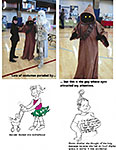


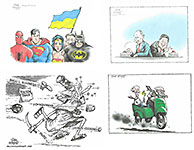
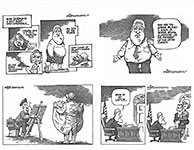
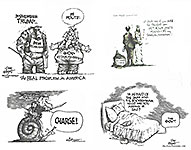
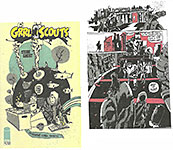
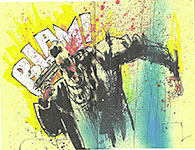
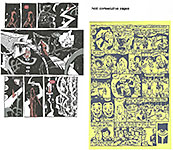
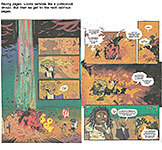
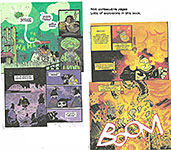
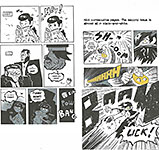
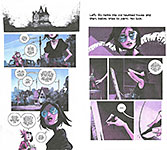
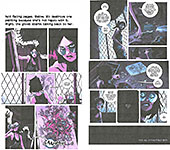
1.jpg)
2.jpg)
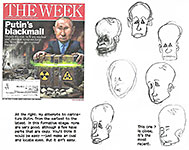
1.jpg)
2.jpg)
3.jpg)
4.jpg)
5.jpg)
6.jpg)
7.jpg)
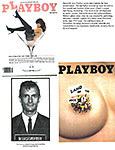
8.jpg)
9.jpg)
10.jpg)
11.jpg)
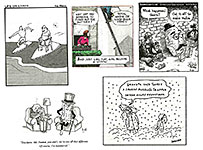
12.jpg)
13.jpg)
14.jpg)
15.jpg)
16.jpg)
17.jpg)
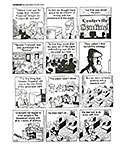
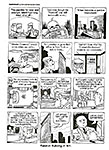
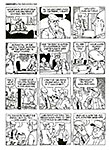
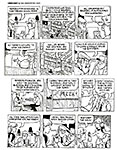
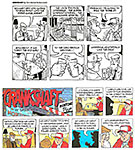
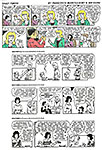



1.jpg)


